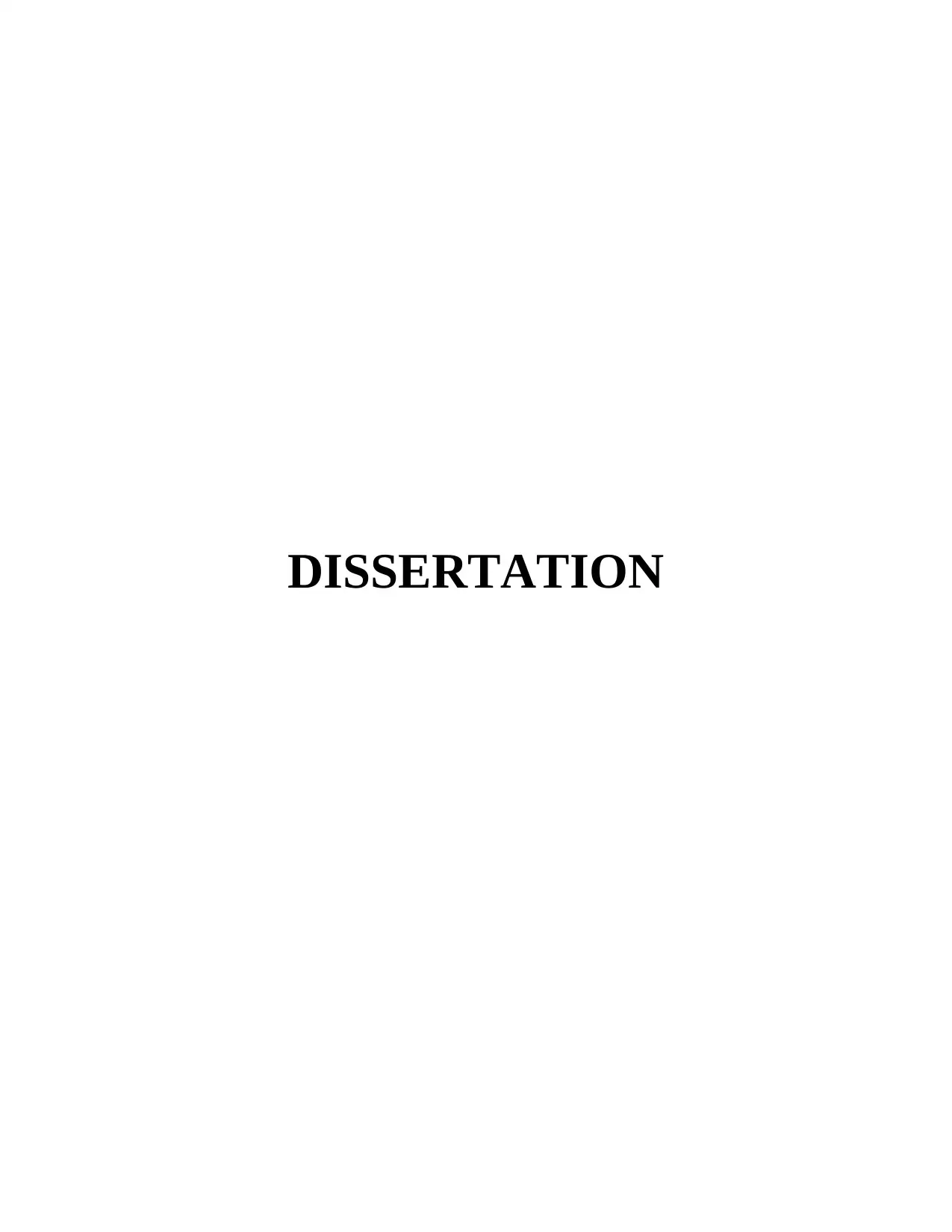
Paraphrase This Document
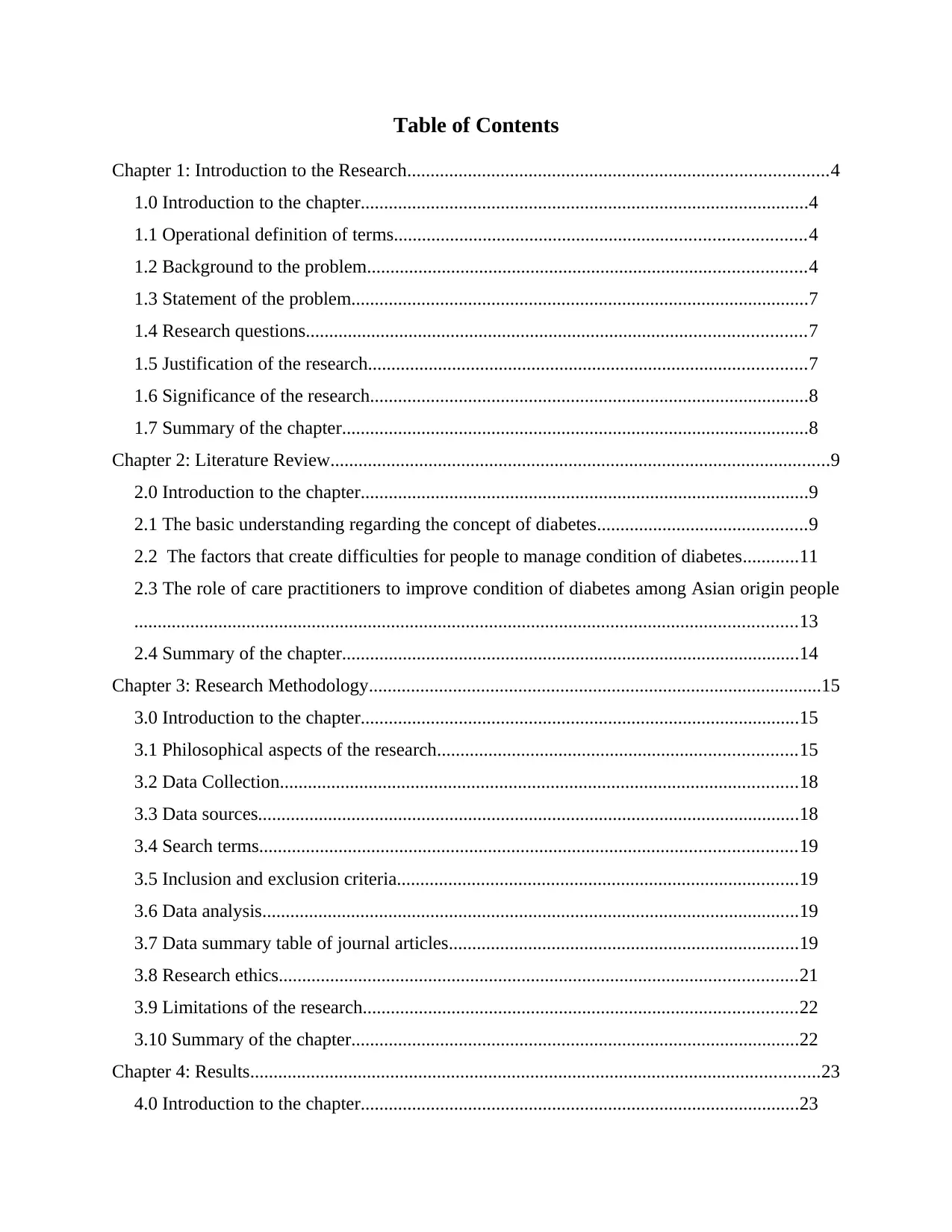
Chapter 1: Introduction to the Research..........................................................................................4
1.0 Introduction to the chapter................................................................................................4
1.1 Operational definition of terms........................................................................................4
1.2 Background to the problem..............................................................................................4
1.3 Statement of the problem..................................................................................................7
1.4 Research questions...........................................................................................................7
1.5 Justification of the research..............................................................................................7
1.6 Significance of the research..............................................................................................8
1.7 Summary of the chapter....................................................................................................8
Chapter 2: Literature Review...........................................................................................................9
2.0 Introduction to the chapter................................................................................................9
2.1 The basic understanding regarding the concept of diabetes.............................................9
2.2 The factors that create difficulties for people to manage condition of diabetes............11
2.3 The role of care practitioners to improve condition of diabetes among Asian origin people
..............................................................................................................................................13
2.4 Summary of the chapter..................................................................................................14
Chapter 3: Research Methodology.................................................................................................15
3.0 Introduction to the chapter..............................................................................................15
3.1 Philosophical aspects of the research.............................................................................15
3.2 Data Collection...............................................................................................................18
3.3 Data sources....................................................................................................................18
3.4 Search terms...................................................................................................................19
3.5 Inclusion and exclusion criteria......................................................................................19
3.6 Data analysis...................................................................................................................19
3.7 Data summary table of journal articles...........................................................................19
3.8 Research ethics...............................................................................................................21
3.9 Limitations of the research.............................................................................................22
3.10 Summary of the chapter................................................................................................22
Chapter 4: Results..........................................................................................................................23
4.0 Introduction to the chapter..............................................................................................23
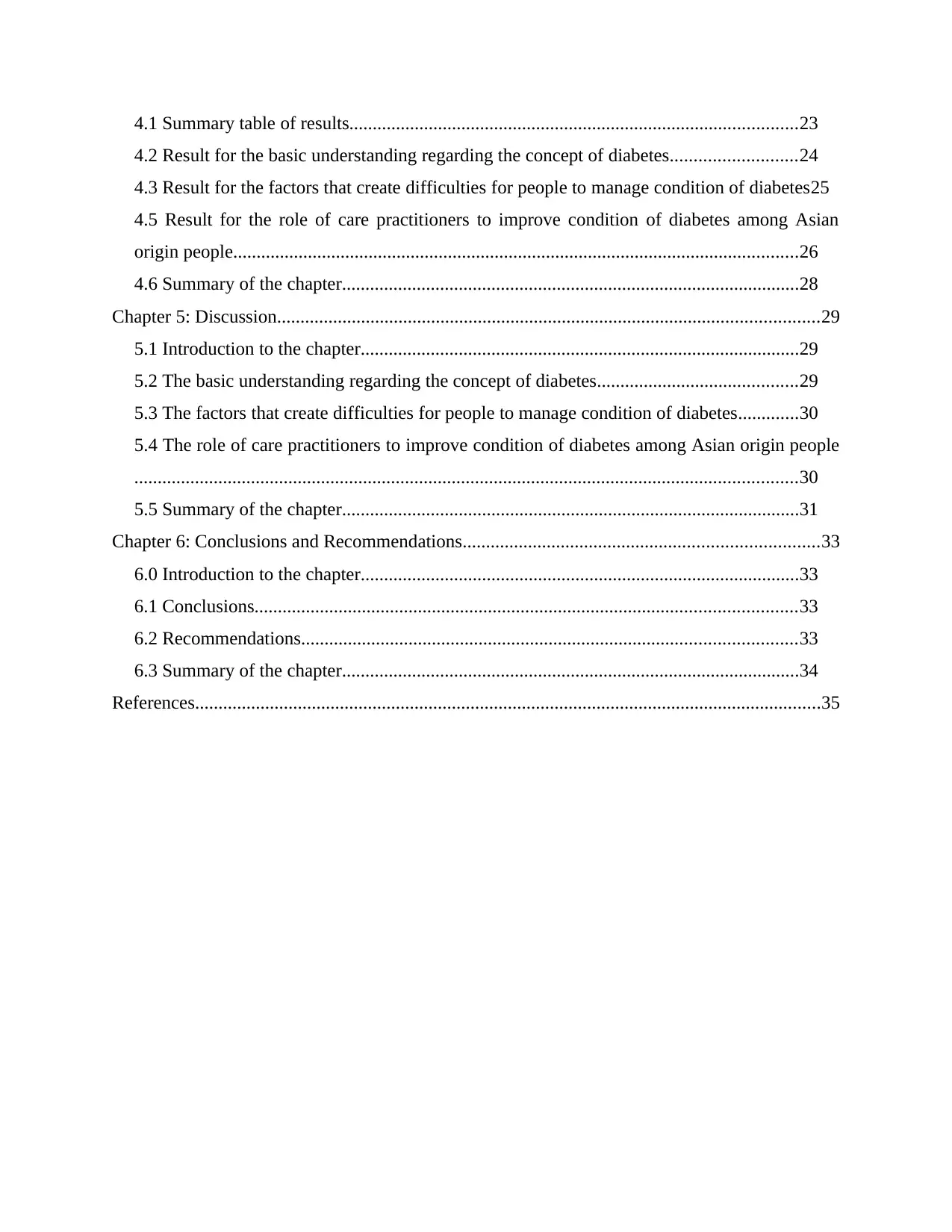
4.2 Result for the basic understanding regarding the concept of diabetes...........................24
4.3 Result for the factors that create difficulties for people to manage condition of diabetes25
4.5 Result for the role of care practitioners to improve condition of diabetes among Asian
origin people.........................................................................................................................26
4.6 Summary of the chapter..................................................................................................28
Chapter 5: Discussion....................................................................................................................29
5.1 Introduction to the chapter..............................................................................................29
5.2 The basic understanding regarding the concept of diabetes...........................................29
5.3 The factors that create difficulties for people to manage condition of diabetes.............30
5.4 The role of care practitioners to improve condition of diabetes among Asian origin people
..............................................................................................................................................30
5.5 Summary of the chapter..................................................................................................31
Chapter 6: Conclusions and Recommendations............................................................................33
6.0 Introduction to the chapter..............................................................................................33
6.1 Conclusions....................................................................................................................33
6.2 Recommendations..........................................................................................................33
6.3 Summary of the chapter..................................................................................................34
References......................................................................................................................................35
⊘ This is a preview!⊘
Do you want full access?
Subscribe today to unlock all pages.

Trusted by 1+ million students worldwide
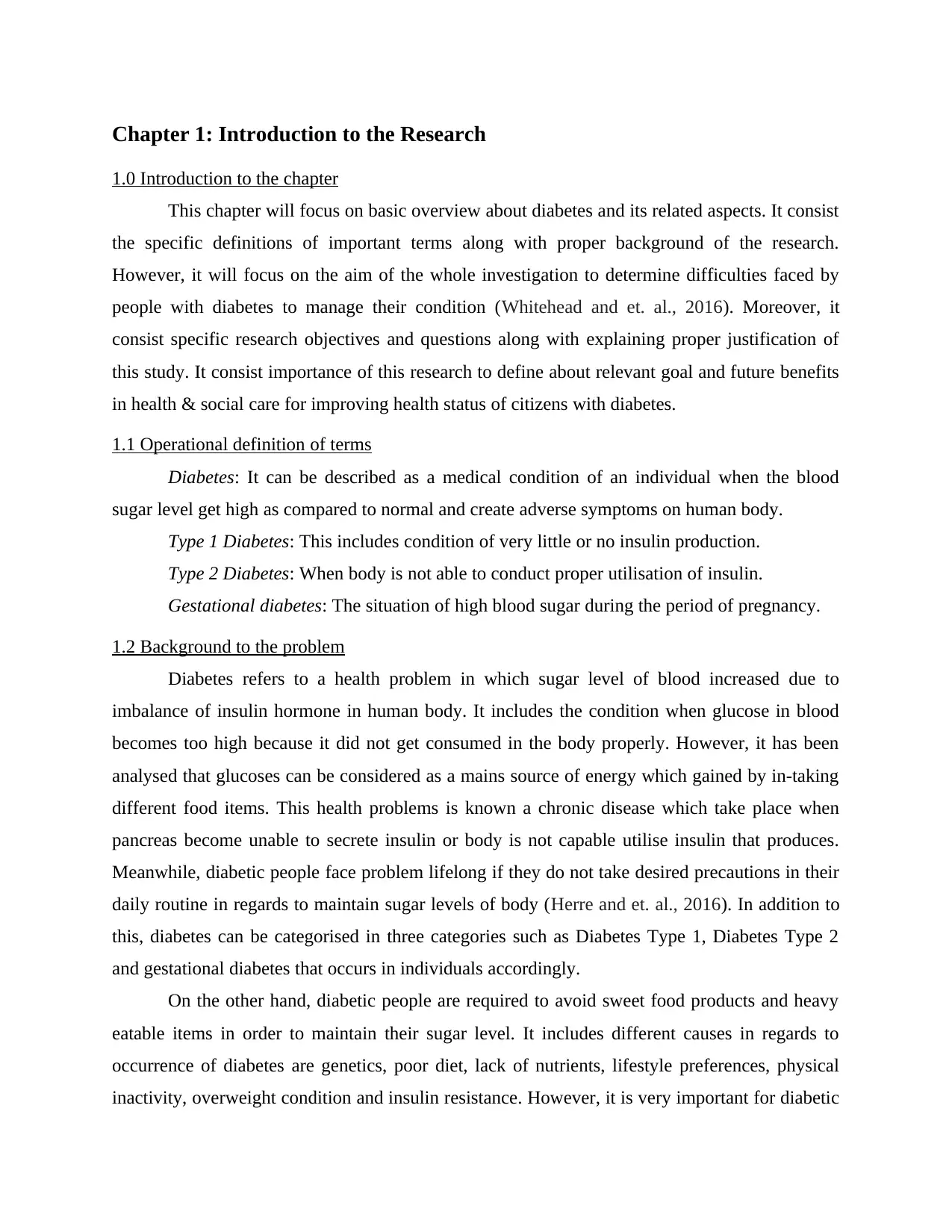
1.0 Introduction to the chapter
This chapter will focus on basic overview about diabetes and its related aspects. It consist
the specific definitions of important terms along with proper background of the research.
However, it will focus on the aim of the whole investigation to determine difficulties faced by
people with diabetes to manage their condition (Whitehead and et. al., 2016). Moreover, it
consist specific research objectives and questions along with explaining proper justification of
this study. It consist importance of this research to define about relevant goal and future benefits
in health & social care for improving health status of citizens with diabetes.
1.1 Operational definition of terms
Diabetes: It can be described as a medical condition of an individual when the blood
sugar level get high as compared to normal and create adverse symptoms on human body.
Type 1 Diabetes: This includes condition of very little or no insulin production.
Type 2 Diabetes: When body is not able to conduct proper utilisation of insulin.
Gestational diabetes: The situation of high blood sugar during the period of pregnancy.
1.2 Background to the problem
Diabetes refers to a health problem in which sugar level of blood increased due to
imbalance of insulin hormone in human body. It includes the condition when glucose in blood
becomes too high because it did not get consumed in the body properly. However, it has been
analysed that glucoses can be considered as a mains source of energy which gained by in-taking
different food items. This health problems is known a chronic disease which take place when
pancreas become unable to secrete insulin or body is not capable utilise insulin that produces.
Meanwhile, diabetic people face problem lifelong if they do not take desired precautions in their
daily routine in regards to maintain sugar levels of body (Herre and et. al., 2016). In addition to
this, diabetes can be categorised in three categories such as Diabetes Type 1, Diabetes Type 2
and gestational diabetes that occurs in individuals accordingly.
On the other hand, diabetic people are required to avoid sweet food products and heavy
eatable items in order to maintain their sugar level. It includes different causes in regards to
occurrence of diabetes are genetics, poor diet, lack of nutrients, lifestyle preferences, physical
inactivity, overweight condition and insulin resistance. However, it is very important for diabetic
Paraphrase This Document
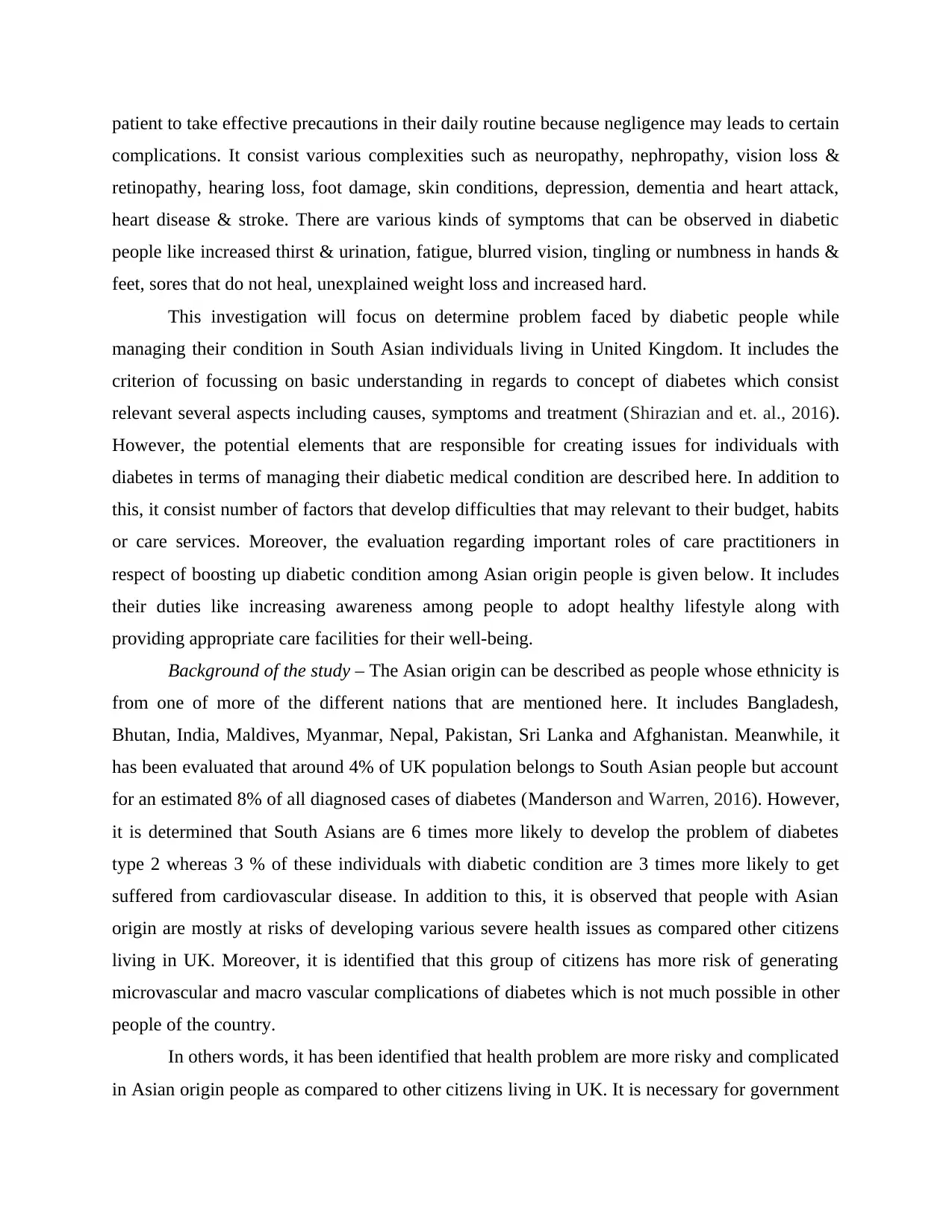
complications. It consist various complexities such as neuropathy, nephropathy, vision loss &
retinopathy, hearing loss, foot damage, skin conditions, depression, dementia and heart attack,
heart disease & stroke. There are various kinds of symptoms that can be observed in diabetic
people like increased thirst & urination, fatigue, blurred vision, tingling or numbness in hands &
feet, sores that do not heal, unexplained weight loss and increased hard.
This investigation will focus on determine problem faced by diabetic people while
managing their condition in South Asian individuals living in United Kingdom. It includes the
criterion of focussing on basic understanding in regards to concept of diabetes which consist
relevant several aspects including causes, symptoms and treatment (Shirazian and et. al., 2016).
However, the potential elements that are responsible for creating issues for individuals with
diabetes in terms of managing their diabetic medical condition are described here. In addition to
this, it consist number of factors that develop difficulties that may relevant to their budget, habits
or care services. Moreover, the evaluation regarding important roles of care practitioners in
respect of boosting up diabetic condition among Asian origin people is given below. It includes
their duties like increasing awareness among people to adopt healthy lifestyle along with
providing appropriate care facilities for their well-being.
Background of the study – The Asian origin can be described as people whose ethnicity is
from one of more of the different nations that are mentioned here. It includes Bangladesh,
Bhutan, India, Maldives, Myanmar, Nepal, Pakistan, Sri Lanka and Afghanistan. Meanwhile, it
has been evaluated that around 4% of UK population belongs to South Asian people but account
for an estimated 8% of all diagnosed cases of diabetes (Manderson and Warren, 2016). However,
it is determined that South Asians are 6 times more likely to develop the problem of diabetes
type 2 whereas 3 % of these individuals with diabetic condition are 3 times more likely to get
suffered from cardiovascular disease. In addition to this, it is observed that people with Asian
origin are mostly at risks of developing various severe health issues as compared other citizens
living in UK. Moreover, it is identified that this group of citizens has more risk of generating
microvascular and macro vascular complications of diabetes which is not much possible in other
people of the country.
In others words, it has been identified that health problem are more risky and complicated
in Asian origin people as compared to other citizens living in UK. It is necessary for government
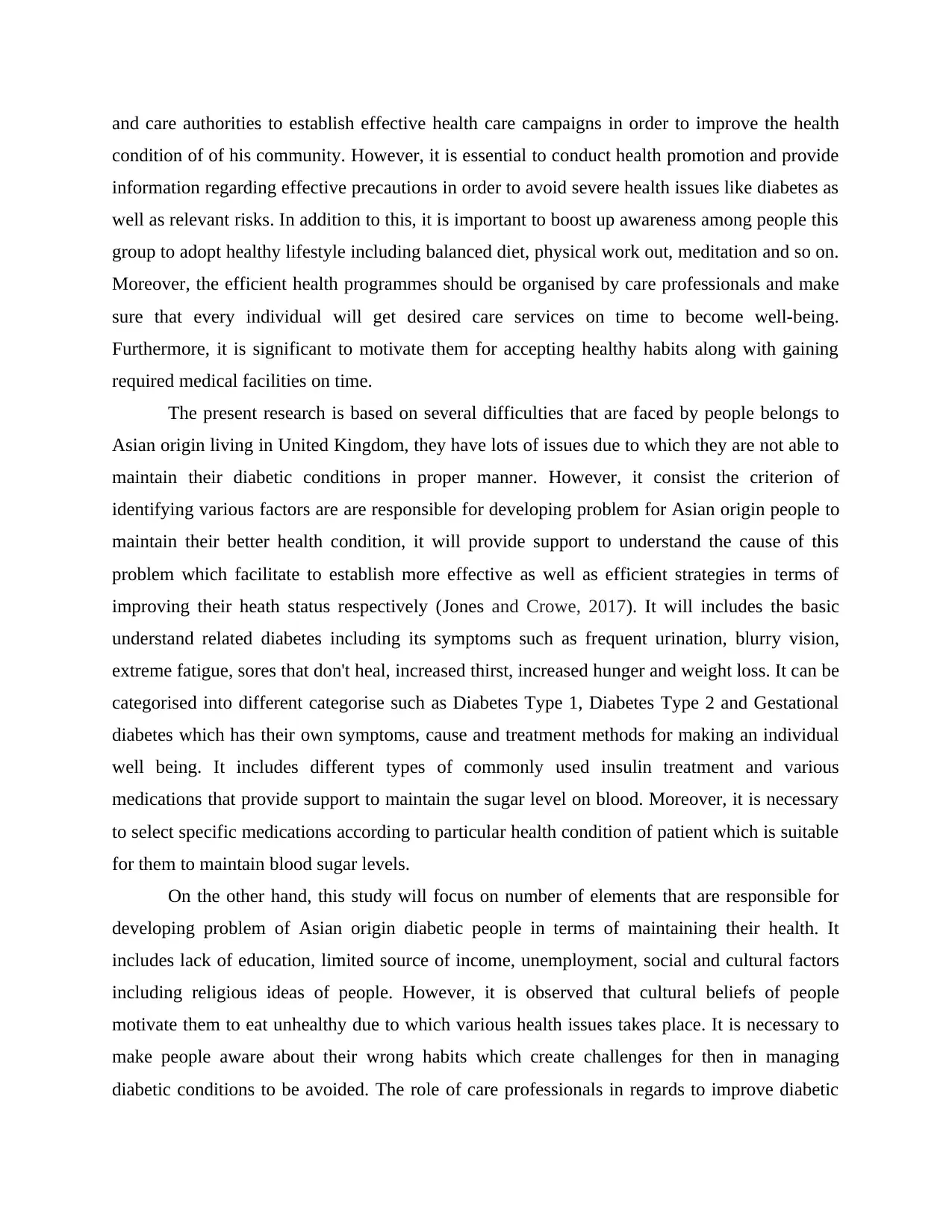
condition of of his community. However, it is essential to conduct health promotion and provide
information regarding effective precautions in order to avoid severe health issues like diabetes as
well as relevant risks. In addition to this, it is important to boost up awareness among people this
group to adopt healthy lifestyle including balanced diet, physical work out, meditation and so on.
Moreover, the efficient health programmes should be organised by care professionals and make
sure that every individual will get desired care services on time to become well-being.
Furthermore, it is significant to motivate them for accepting healthy habits along with gaining
required medical facilities on time.
The present research is based on several difficulties that are faced by people belongs to
Asian origin living in United Kingdom, they have lots of issues due to which they are not able to
maintain their diabetic conditions in proper manner. However, it consist the criterion of
identifying various factors are are responsible for developing problem for Asian origin people to
maintain their better health condition, it will provide support to understand the cause of this
problem which facilitate to establish more effective as well as efficient strategies in terms of
improving their heath status respectively (Jones and Crowe, 2017). It will includes the basic
understand related diabetes including its symptoms such as frequent urination, blurry vision,
extreme fatigue, sores that don't heal, increased thirst, increased hunger and weight loss. It can be
categorised into different categorise such as Diabetes Type 1, Diabetes Type 2 and Gestational
diabetes which has their own symptoms, cause and treatment methods for making an individual
well being. It includes different types of commonly used insulin treatment and various
medications that provide support to maintain the sugar level on blood. Moreover, it is necessary
to select specific medications according to particular health condition of patient which is suitable
for them to maintain blood sugar levels.
On the other hand, this study will focus on number of elements that are responsible for
developing problem of Asian origin diabetic people in terms of maintaining their health. It
includes lack of education, limited source of income, unemployment, social and cultural factors
including religious ideas of people. However, it is observed that cultural beliefs of people
motivate them to eat unhealthy due to which various health issues takes place. It is necessary to
make people aware about their wrong habits which create challenges for then in managing
diabetic conditions to be avoided. The role of care professionals in regards to improve diabetic
⊘ This is a preview!⊘
Do you want full access?
Subscribe today to unlock all pages.

Trusted by 1+ million students worldwide
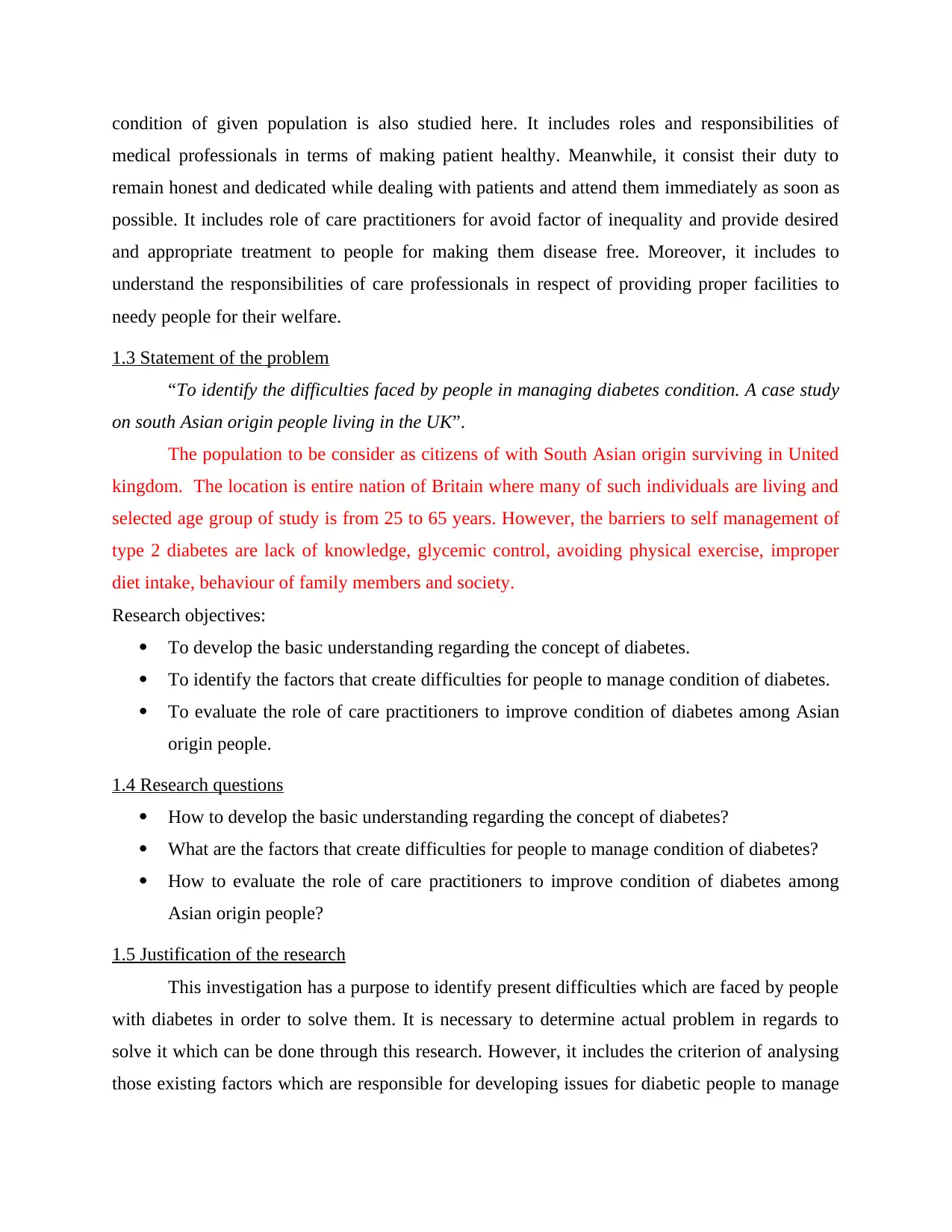
medical professionals in terms of making patient healthy. Meanwhile, it consist their duty to
remain honest and dedicated while dealing with patients and attend them immediately as soon as
possible. It includes role of care practitioners for avoid factor of inequality and provide desired
and appropriate treatment to people for making them disease free. Moreover, it includes to
understand the responsibilities of care professionals in respect of providing proper facilities to
needy people for their welfare.
1.3 Statement of the problem
“To identify the difficulties faced by people in managing diabetes condition. A case study
on south Asian origin people living in the UK”.
The population to be consider as citizens of with South Asian origin surviving in United
kingdom. The location is entire nation of Britain where many of such individuals are living and
selected age group of study is from 25 to 65 years. However, the barriers to self management of
type 2 diabetes are lack of knowledge, glycemic control, avoiding physical exercise, improper
diet intake, behaviour of family members and society.
Research objectives:
To develop the basic understanding regarding the concept of diabetes.
To identify the factors that create difficulties for people to manage condition of diabetes.
To evaluate the role of care practitioners to improve condition of diabetes among Asian
origin people.
1.4 Research questions
How to develop the basic understanding regarding the concept of diabetes?
What are the factors that create difficulties for people to manage condition of diabetes?
How to evaluate the role of care practitioners to improve condition of diabetes among
Asian origin people?
1.5 Justification of the research
This investigation has a purpose to identify present difficulties which are faced by people
with diabetes in order to solve them. It is necessary to determine actual problem in regards to
solve it which can be done through this research. However, it includes the criterion of analysing
those existing factors which are responsible for developing issues for diabetic people to manage
Paraphrase This Document
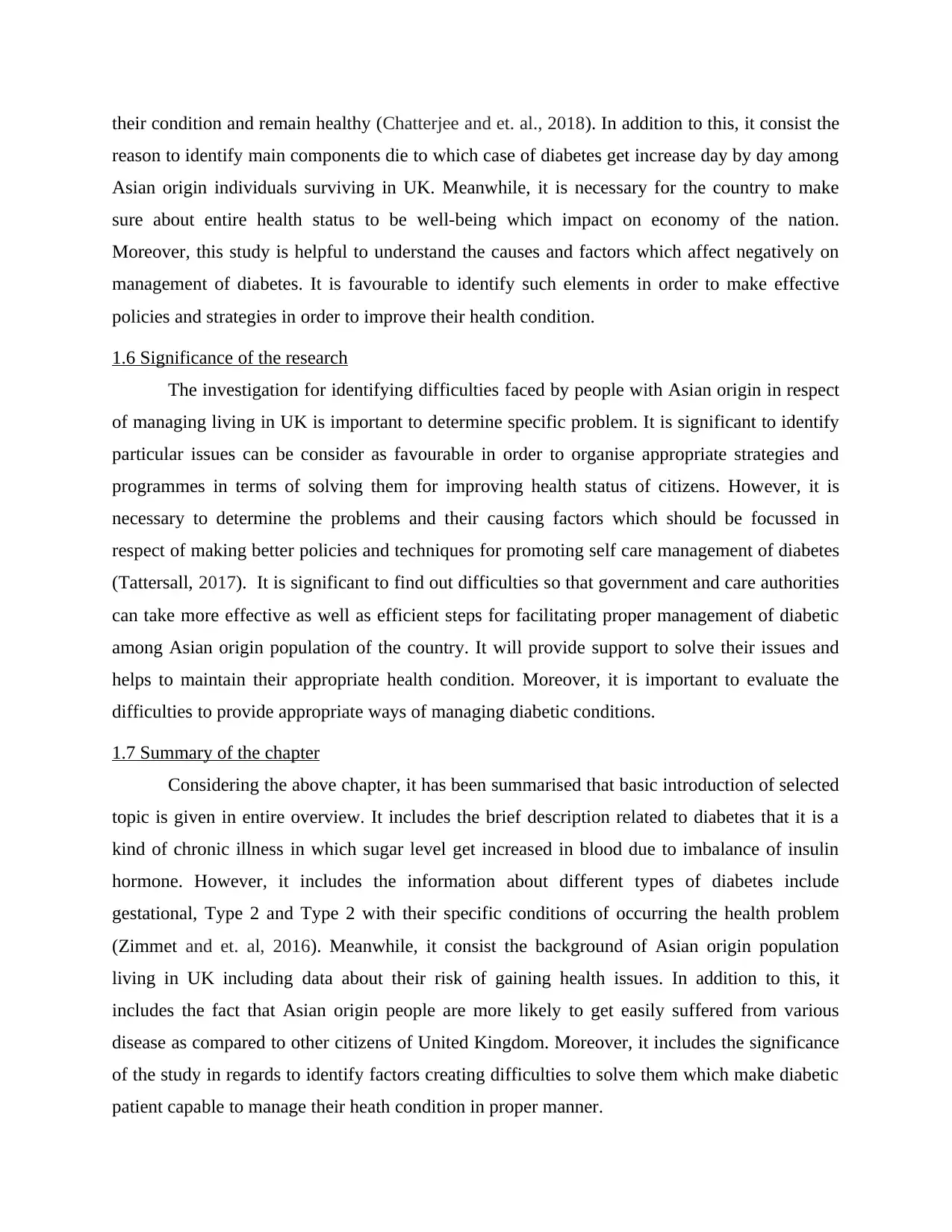
reason to identify main components die to which case of diabetes get increase day by day among
Asian origin individuals surviving in UK. Meanwhile, it is necessary for the country to make
sure about entire health status to be well-being which impact on economy of the nation.
Moreover, this study is helpful to understand the causes and factors which affect negatively on
management of diabetes. It is favourable to identify such elements in order to make effective
policies and strategies in order to improve their health condition.
1.6 Significance of the research
The investigation for identifying difficulties faced by people with Asian origin in respect
of managing living in UK is important to determine specific problem. It is significant to identify
particular issues can be consider as favourable in order to organise appropriate strategies and
programmes in terms of solving them for improving health status of citizens. However, it is
necessary to determine the problems and their causing factors which should be focussed in
respect of making better policies and techniques for promoting self care management of diabetes
(Tattersall, 2017). It is significant to find out difficulties so that government and care authorities
can take more effective as well as efficient steps for facilitating proper management of diabetic
among Asian origin population of the country. It will provide support to solve their issues and
helps to maintain their appropriate health condition. Moreover, it is important to evaluate the
difficulties to provide appropriate ways of managing diabetic conditions.
1.7 Summary of the chapter
Considering the above chapter, it has been summarised that basic introduction of selected
topic is given in entire overview. It includes the brief description related to diabetes that it is a
kind of chronic illness in which sugar level get increased in blood due to imbalance of insulin
hormone. However, it includes the information about different types of diabetes include
gestational, Type 2 and Type 2 with their specific conditions of occurring the health problem
(Zimmet and et. al, 2016). Meanwhile, it consist the background of Asian origin population
living in UK including data about their risk of gaining health issues. In addition to this, it
includes the fact that Asian origin people are more likely to get easily suffered from various
disease as compared to other citizens of United Kingdom. Moreover, it includes the significance
of the study in regards to identify factors creating difficulties to solve them which make diabetic
patient capable to manage their heath condition in proper manner.
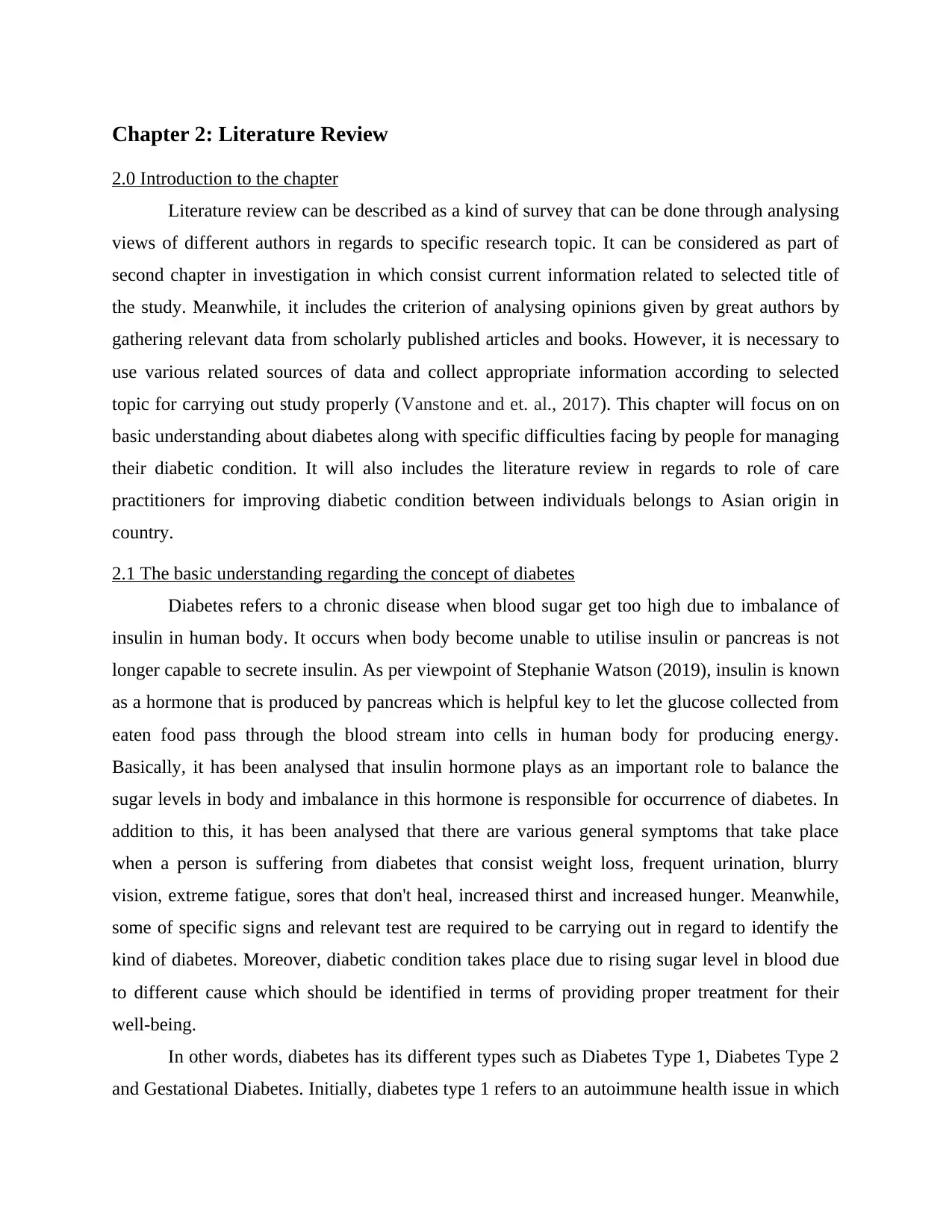
2.0 Introduction to the chapter
Literature review can be described as a kind of survey that can be done through analysing
views of different authors in regards to specific research topic. It can be considered as part of
second chapter in investigation in which consist current information related to selected title of
the study. Meanwhile, it includes the criterion of analysing opinions given by great authors by
gathering relevant data from scholarly published articles and books. However, it is necessary to
use various related sources of data and collect appropriate information according to selected
topic for carrying out study properly (Vanstone and et. al., 2017). This chapter will focus on on
basic understanding about diabetes along with specific difficulties facing by people for managing
their diabetic condition. It will also includes the literature review in regards to role of care
practitioners for improving diabetic condition between individuals belongs to Asian origin in
country.
2.1 The basic understanding regarding the concept of diabetes
Diabetes refers to a chronic disease when blood sugar get too high due to imbalance of
insulin in human body. It occurs when body become unable to utilise insulin or pancreas is not
longer capable to secrete insulin. As per viewpoint of Stephanie Watson (2019), insulin is known
as a hormone that is produced by pancreas which is helpful key to let the glucose collected from
eaten food pass through the blood stream into cells in human body for producing energy.
Basically, it has been analysed that insulin hormone plays as an important role to balance the
sugar levels in body and imbalance in this hormone is responsible for occurrence of diabetes. In
addition to this, it has been analysed that there are various general symptoms that take place
when a person is suffering from diabetes that consist weight loss, frequent urination, blurry
vision, extreme fatigue, sores that don't heal, increased thirst and increased hunger. Meanwhile,
some of specific signs and relevant test are required to be carrying out in regard to identify the
kind of diabetes. Moreover, diabetic condition takes place due to rising sugar level in blood due
to different cause which should be identified in terms of providing proper treatment for their
well-being.
In other words, diabetes has its different types such as Diabetes Type 1, Diabetes Type 2
and Gestational Diabetes. Initially, diabetes type 1 refers to an autoimmune health issue in which
⊘ This is a preview!⊘
Do you want full access?
Subscribe today to unlock all pages.

Trusted by 1+ million students worldwide
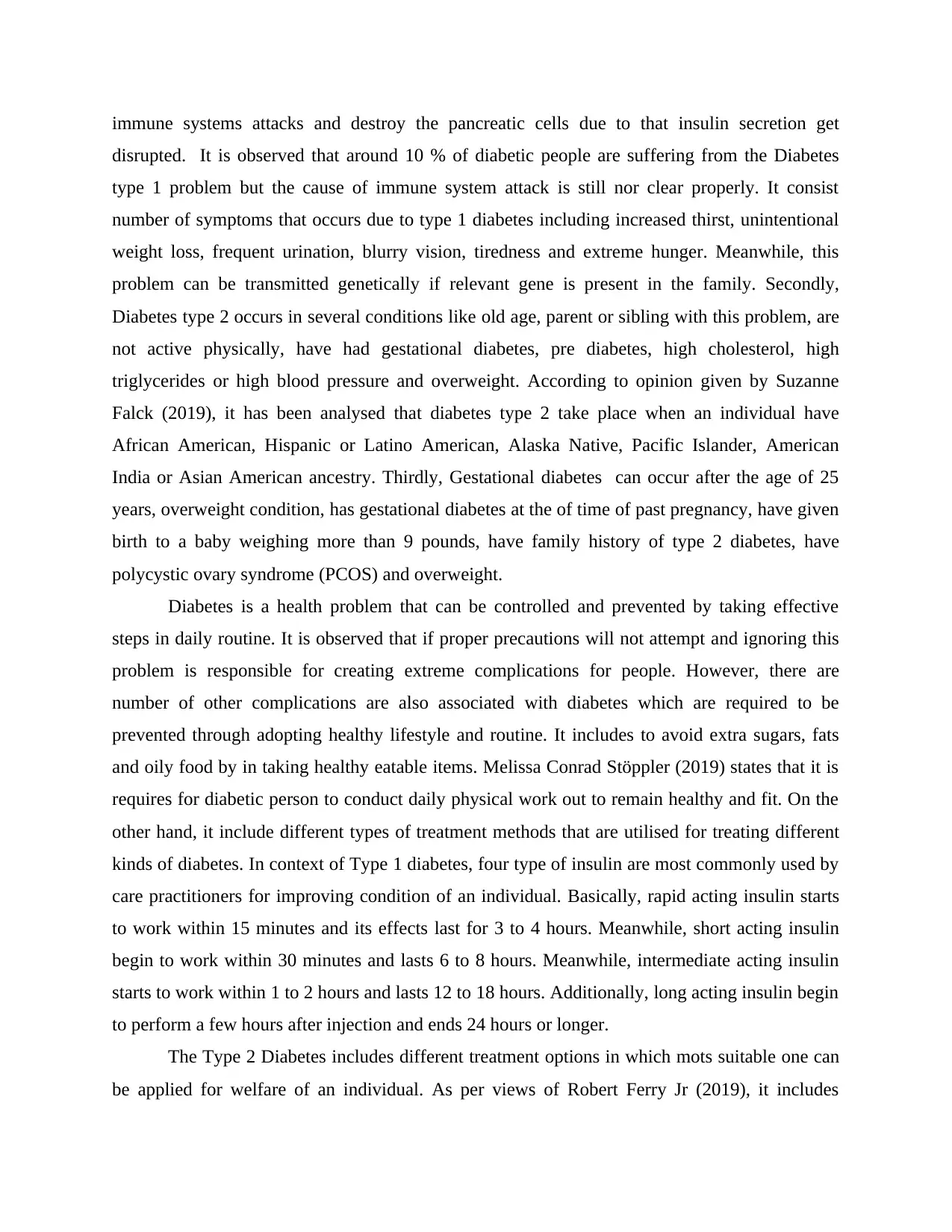
disrupted. It is observed that around 10 % of diabetic people are suffering from the Diabetes
type 1 problem but the cause of immune system attack is still nor clear properly. It consist
number of symptoms that occurs due to type 1 diabetes including increased thirst, unintentional
weight loss, frequent urination, blurry vision, tiredness and extreme hunger. Meanwhile, this
problem can be transmitted genetically if relevant gene is present in the family. Secondly,
Diabetes type 2 occurs in several conditions like old age, parent or sibling with this problem, are
not active physically, have had gestational diabetes, pre diabetes, high cholesterol, high
triglycerides or high blood pressure and overweight. According to opinion given by Suzanne
Falck (2019), it has been analysed that diabetes type 2 take place when an individual have
African American, Hispanic or Latino American, Alaska Native, Pacific Islander, American
India or Asian American ancestry. Thirdly, Gestational diabetes can occur after the age of 25
years, overweight condition, has gestational diabetes at the of time of past pregnancy, have given
birth to a baby weighing more than 9 pounds, have family history of type 2 diabetes, have
polycystic ovary syndrome (PCOS) and overweight.
Diabetes is a health problem that can be controlled and prevented by taking effective
steps in daily routine. It is observed that if proper precautions will not attempt and ignoring this
problem is responsible for creating extreme complications for people. However, there are
number of other complications are also associated with diabetes which are required to be
prevented through adopting healthy lifestyle and routine. It includes to avoid extra sugars, fats
and oily food by in taking healthy eatable items. Melissa Conrad Stöppler (2019) states that it is
requires for diabetic person to conduct daily physical work out to remain healthy and fit. On the
other hand, it include different types of treatment methods that are utilised for treating different
kinds of diabetes. In context of Type 1 diabetes, four type of insulin are most commonly used by
care practitioners for improving condition of an individual. Basically, rapid acting insulin starts
to work within 15 minutes and its effects last for 3 to 4 hours. Meanwhile, short acting insulin
begin to work within 30 minutes and lasts 6 to 8 hours. Meanwhile, intermediate acting insulin
starts to work within 1 to 2 hours and lasts 12 to 18 hours. Additionally, long acting insulin begin
to perform a few hours after injection and ends 24 hours or longer.
The Type 2 Diabetes includes different treatment options in which mots suitable one can
be applied for welfare of an individual. As per views of Robert Ferry Jr (2019), it includes
Paraphrase This Document
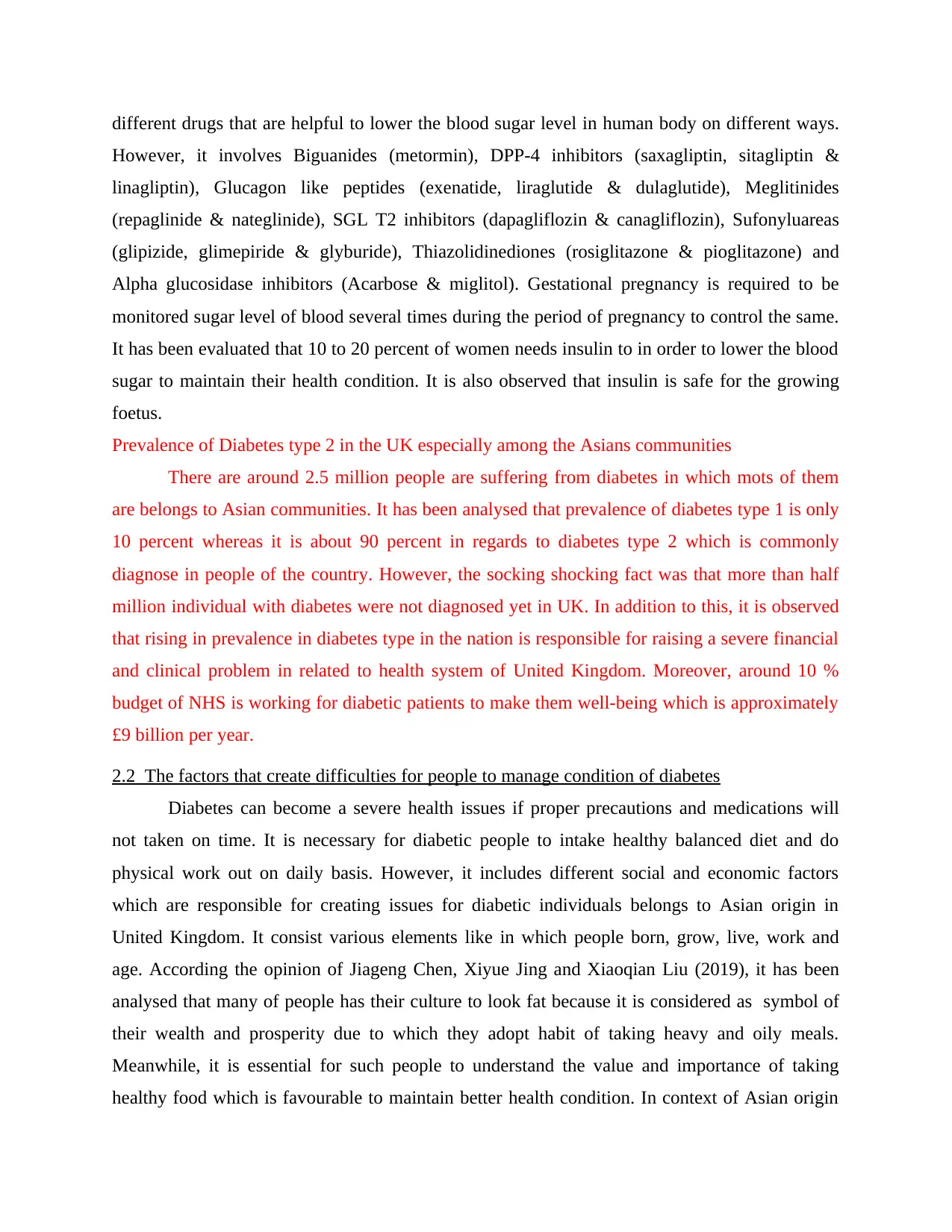
However, it involves Biguanides (metormin), DPP-4 inhibitors (saxagliptin, sitagliptin &
linagliptin), Glucagon like peptides (exenatide, liraglutide & dulaglutide), Meglitinides
(repaglinide & nateglinide), SGL T2 inhibitors (dapagliflozin & canagliflozin), Sufonyluareas
(glipizide, glimepiride & glyburide), Thiazolidinediones (rosiglitazone & pioglitazone) and
Alpha glucosidase inhibitors (Acarbose & miglitol). Gestational pregnancy is required to be
monitored sugar level of blood several times during the period of pregnancy to control the same.
It has been evaluated that 10 to 20 percent of women needs insulin to in order to lower the blood
sugar to maintain their health condition. It is also observed that insulin is safe for the growing
foetus.
Prevalence of Diabetes type 2 in the UK especially among the Asians communities
There are around 2.5 million people are suffering from diabetes in which mots of them
are belongs to Asian communities. It has been analysed that prevalence of diabetes type 1 is only
10 percent whereas it is about 90 percent in regards to diabetes type 2 which is commonly
diagnose in people of the country. However, the socking shocking fact was that more than half
million individual with diabetes were not diagnosed yet in UK. In addition to this, it is observed
that rising in prevalence in diabetes type in the nation is responsible for raising a severe financial
and clinical problem in related to health system of United Kingdom. Moreover, around 10 %
budget of NHS is working for diabetic patients to make them well-being which is approximately
£9 billion per year.
2.2 The factors that create difficulties for people to manage condition of diabetes
Diabetes can become a severe health issues if proper precautions and medications will
not taken on time. It is necessary for diabetic people to intake healthy balanced diet and do
physical work out on daily basis. However, it includes different social and economic factors
which are responsible for creating issues for diabetic individuals belongs to Asian origin in
United Kingdom. It consist various elements like in which people born, grow, live, work and
age. According the opinion of Jiageng Chen, Xiyue Jing and Xiaoqian Liu (2019), it has been
analysed that many of people has their culture to look fat because it is considered as symbol of
their wealth and prosperity due to which they adopt habit of taking heavy and oily meals.
Meanwhile, it is essential for such people to understand the value and importance of taking
healthy food which is favourable to maintain better health condition. In context of Asian origin
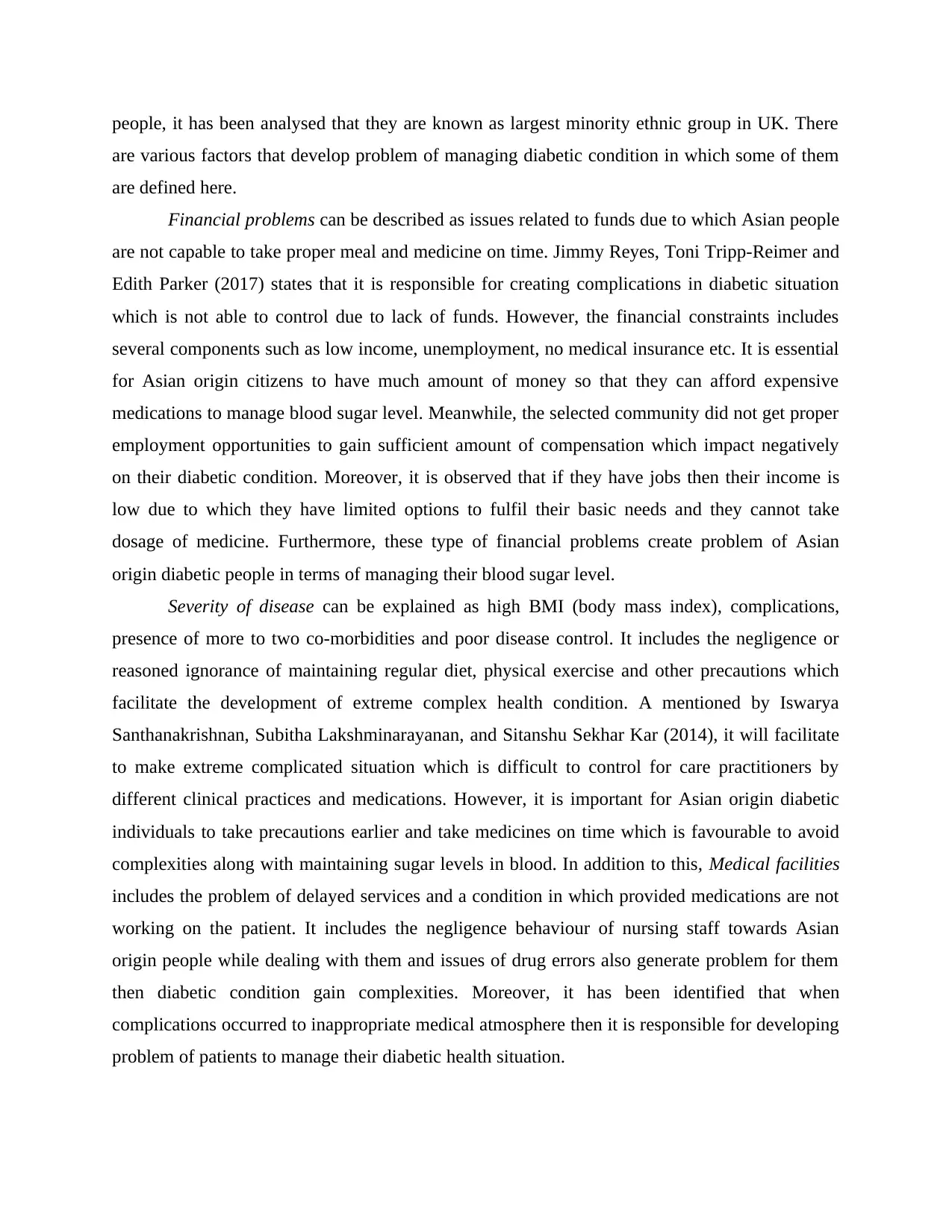
are various factors that develop problem of managing diabetic condition in which some of them
are defined here.
Financial problems can be described as issues related to funds due to which Asian people
are not capable to take proper meal and medicine on time. Jimmy Reyes, Toni Tripp-Reimer and
Edith Parker (2017) states that it is responsible for creating complications in diabetic situation
which is not able to control due to lack of funds. However, the financial constraints includes
several components such as low income, unemployment, no medical insurance etc. It is essential
for Asian origin citizens to have much amount of money so that they can afford expensive
medications to manage blood sugar level. Meanwhile, the selected community did not get proper
employment opportunities to gain sufficient amount of compensation which impact negatively
on their diabetic condition. Moreover, it is observed that if they have jobs then their income is
low due to which they have limited options to fulfil their basic needs and they cannot take
dosage of medicine. Furthermore, these type of financial problems create problem of Asian
origin diabetic people in terms of managing their blood sugar level.
Severity of disease can be explained as high BMI (body mass index), complications,
presence of more to two co-morbidities and poor disease control. It includes the negligence or
reasoned ignorance of maintaining regular diet, physical exercise and other precautions which
facilitate the development of extreme complex health condition. A mentioned by Iswarya
Santhanakrishnan, Subitha Lakshminarayanan, and Sitanshu Sekhar Kar (2014), it will facilitate
to make extreme complicated situation which is difficult to control for care practitioners by
different clinical practices and medications. However, it is important for Asian origin diabetic
individuals to take precautions earlier and take medicines on time which is favourable to avoid
complexities along with maintaining sugar levels in blood. In addition to this, Medical facilities
includes the problem of delayed services and a condition in which provided medications are not
working on the patient. It includes the negligence behaviour of nursing staff towards Asian
origin people while dealing with them and issues of drug errors also generate problem for them
then diabetic condition gain complexities. Moreover, it has been identified that when
complications occurred to inappropriate medical atmosphere then it is responsible for developing
problem of patients to manage their diabetic health situation.
⊘ This is a preview!⊘
Do you want full access?
Subscribe today to unlock all pages.

Trusted by 1+ million students worldwide
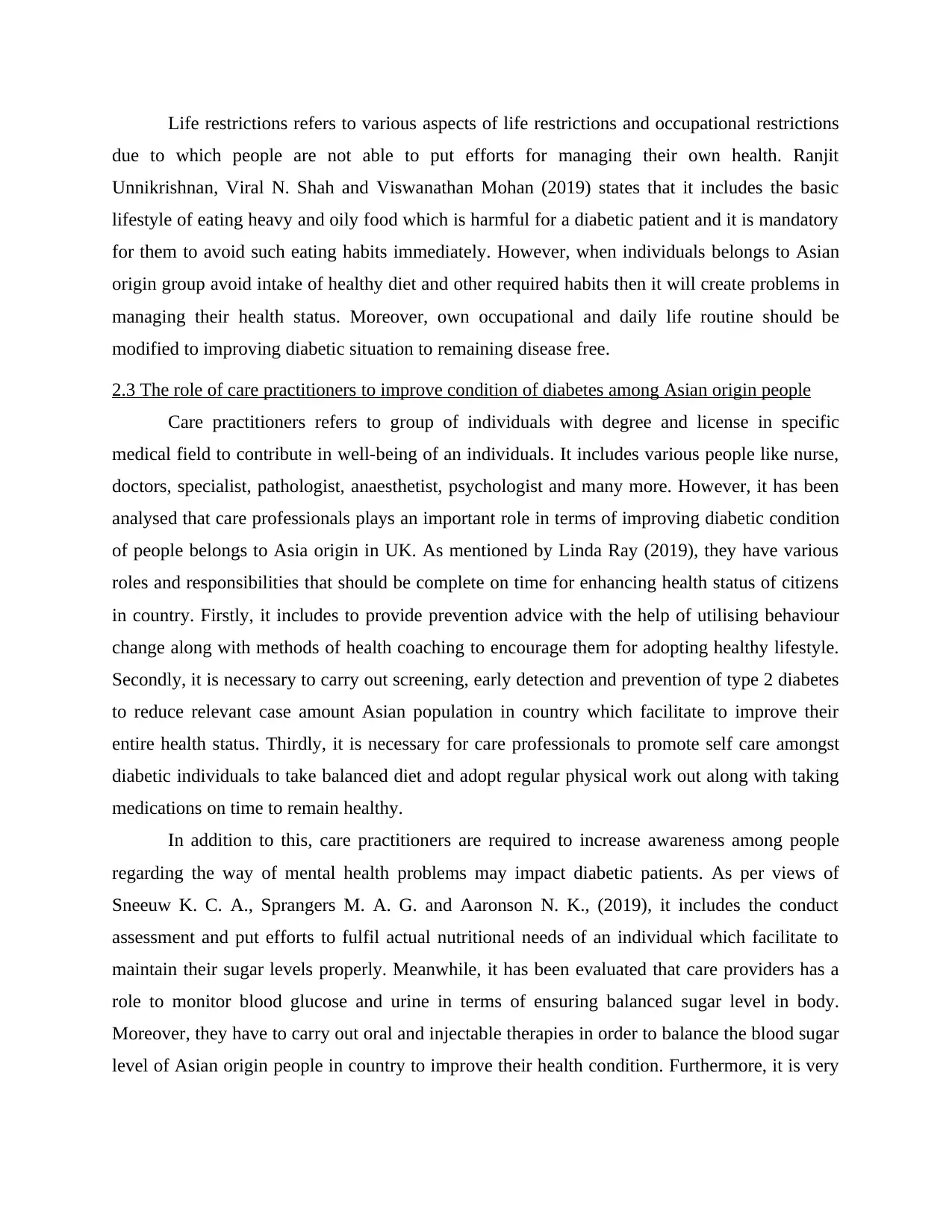
due to which people are not able to put efforts for managing their own health. Ranjit
Unnikrishnan, Viral N. Shah and Viswanathan Mohan (2019) states that it includes the basic
lifestyle of eating heavy and oily food which is harmful for a diabetic patient and it is mandatory
for them to avoid such eating habits immediately. However, when individuals belongs to Asian
origin group avoid intake of healthy diet and other required habits then it will create problems in
managing their health status. Moreover, own occupational and daily life routine should be
modified to improving diabetic situation to remaining disease free.
2.3 The role of care practitioners to improve condition of diabetes among Asian origin people
Care practitioners refers to group of individuals with degree and license in specific
medical field to contribute in well-being of an individuals. It includes various people like nurse,
doctors, specialist, pathologist, anaesthetist, psychologist and many more. However, it has been
analysed that care professionals plays an important role in terms of improving diabetic condition
of people belongs to Asia origin in UK. As mentioned by Linda Ray (2019), they have various
roles and responsibilities that should be complete on time for enhancing health status of citizens
in country. Firstly, it includes to provide prevention advice with the help of utilising behaviour
change along with methods of health coaching to encourage them for adopting healthy lifestyle.
Secondly, it is necessary to carry out screening, early detection and prevention of type 2 diabetes
to reduce relevant case amount Asian population in country which facilitate to improve their
entire health status. Thirdly, it is necessary for care professionals to promote self care amongst
diabetic individuals to take balanced diet and adopt regular physical work out along with taking
medications on time to remain healthy.
In addition to this, care practitioners are required to increase awareness among people
regarding the way of mental health problems may impact diabetic patients. As per views of
Sneeuw K. C. A., Sprangers M. A. G. and Aaronson N. K., (2019), it includes the conduct
assessment and put efforts to fulfil actual nutritional needs of an individual which facilitate to
maintain their sugar levels properly. Meanwhile, it has been evaluated that care providers has a
role to monitor blood glucose and urine in terms of ensuring balanced sugar level in body.
Moreover, they have to carry out oral and injectable therapies in order to balance the blood sugar
level of Asian origin people in country to improve their health condition. Furthermore, it is very
Paraphrase This Document
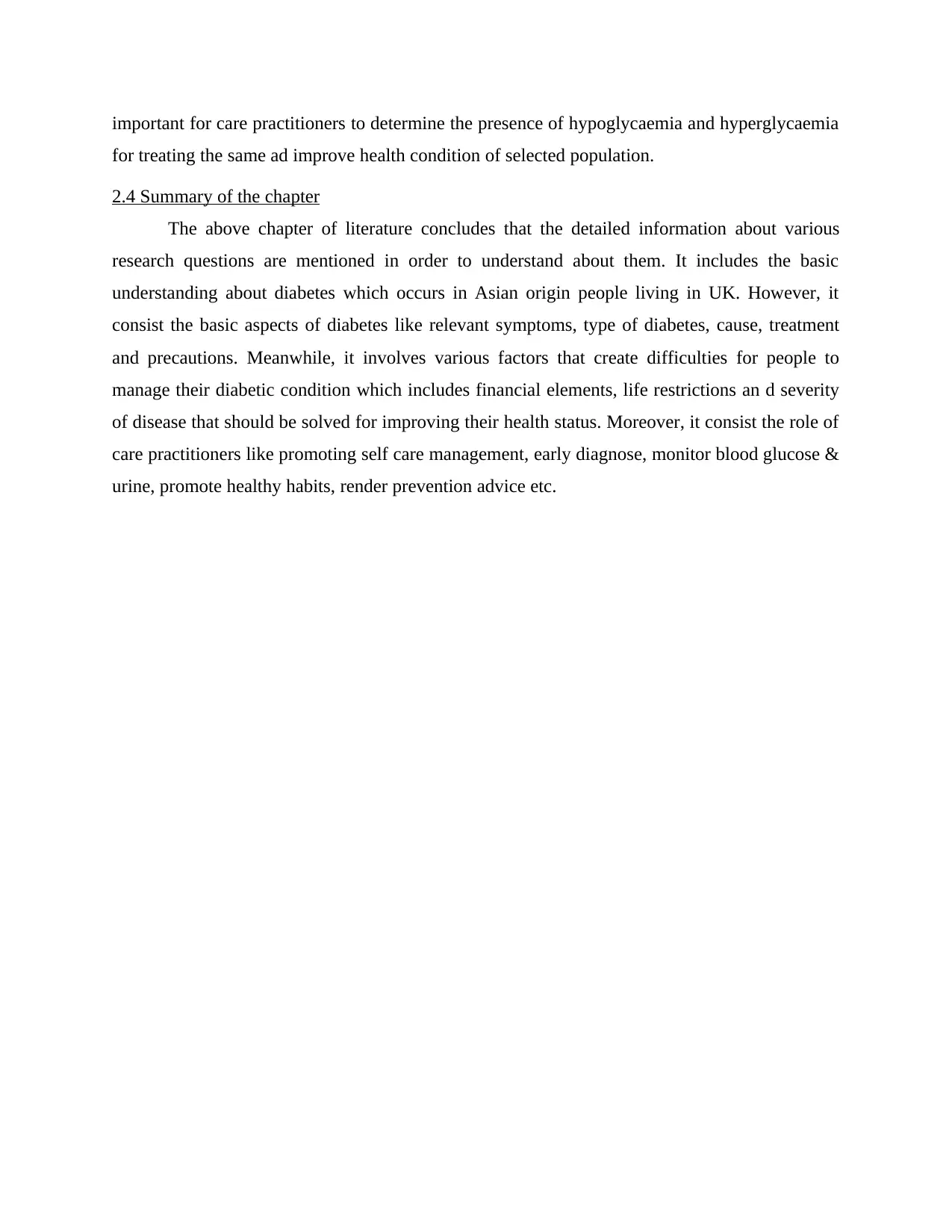
for treating the same ad improve health condition of selected population.
2.4 Summary of the chapter
The above chapter of literature concludes that the detailed information about various
research questions are mentioned in order to understand about them. It includes the basic
understanding about diabetes which occurs in Asian origin people living in UK. However, it
consist the basic aspects of diabetes like relevant symptoms, type of diabetes, cause, treatment
and precautions. Meanwhile, it involves various factors that create difficulties for people to
manage their diabetic condition which includes financial elements, life restrictions an d severity
of disease that should be solved for improving their health status. Moreover, it consist the role of
care practitioners like promoting self care management, early diagnose, monitor blood glucose &
urine, promote healthy habits, render prevention advice etc.
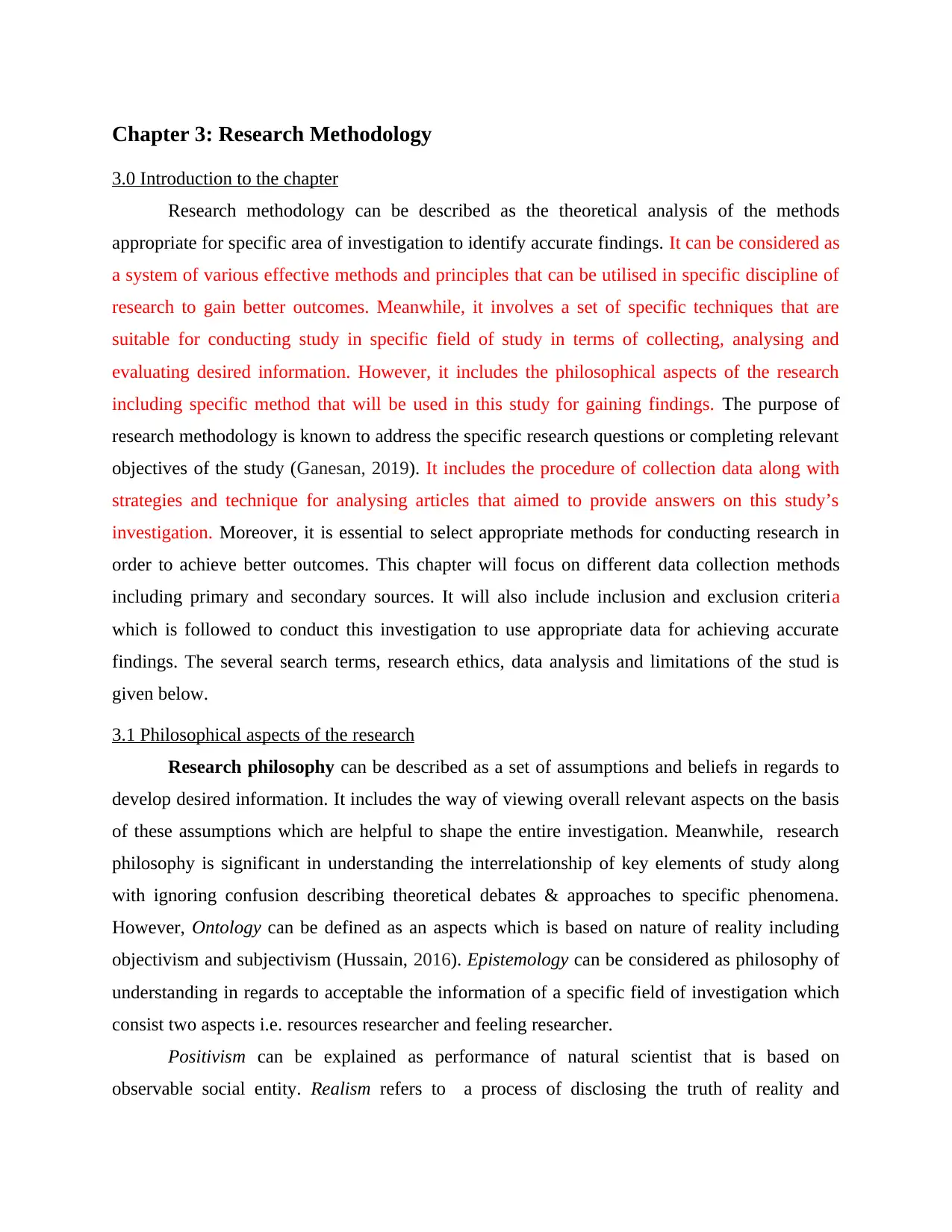
3.0 Introduction to the chapter
Research methodology can be described as the theoretical analysis of the methods
appropriate for specific area of investigation to identify accurate findings. It can be considered as
a system of various effective methods and principles that can be utilised in specific discipline of
research to gain better outcomes. Meanwhile, it involves a set of specific techniques that are
suitable for conducting study in specific field of study in terms of collecting, analysing and
evaluating desired information. However, it includes the philosophical aspects of the research
including specific method that will be used in this study for gaining findings. The purpose of
research methodology is known to address the specific research questions or completing relevant
objectives of the study (Ganesan, 2019). It includes the procedure of collection data along with
strategies and technique for analysing articles that aimed to provide answers on this study’s
investigation. Moreover, it is essential to select appropriate methods for conducting research in
order to achieve better outcomes. This chapter will focus on different data collection methods
including primary and secondary sources. It will also include inclusion and exclusion criteria
which is followed to conduct this investigation to use appropriate data for achieving accurate
findings. The several search terms, research ethics, data analysis and limitations of the stud is
given below.
3.1 Philosophical aspects of the research
Research philosophy can be described as a set of assumptions and beliefs in regards to
develop desired information. It includes the way of viewing overall relevant aspects on the basis
of these assumptions which are helpful to shape the entire investigation. Meanwhile, research
philosophy is significant in understanding the interrelationship of key elements of study along
with ignoring confusion describing theoretical debates & approaches to specific phenomena.
However, Ontology can be defined as an aspects which is based on nature of reality including
objectivism and subjectivism (Hussain, 2016). Epistemology can be considered as philosophy of
understanding in regards to acceptable the information of a specific field of investigation which
consist two aspects i.e. resources researcher and feeling researcher.
Positivism can be explained as performance of natural scientist that is based on
observable social entity. Realism refers to a process of disclosing the truth of reality and
⊘ This is a preview!⊘
Do you want full access?
Subscribe today to unlock all pages.

Trusted by 1+ million students worldwide
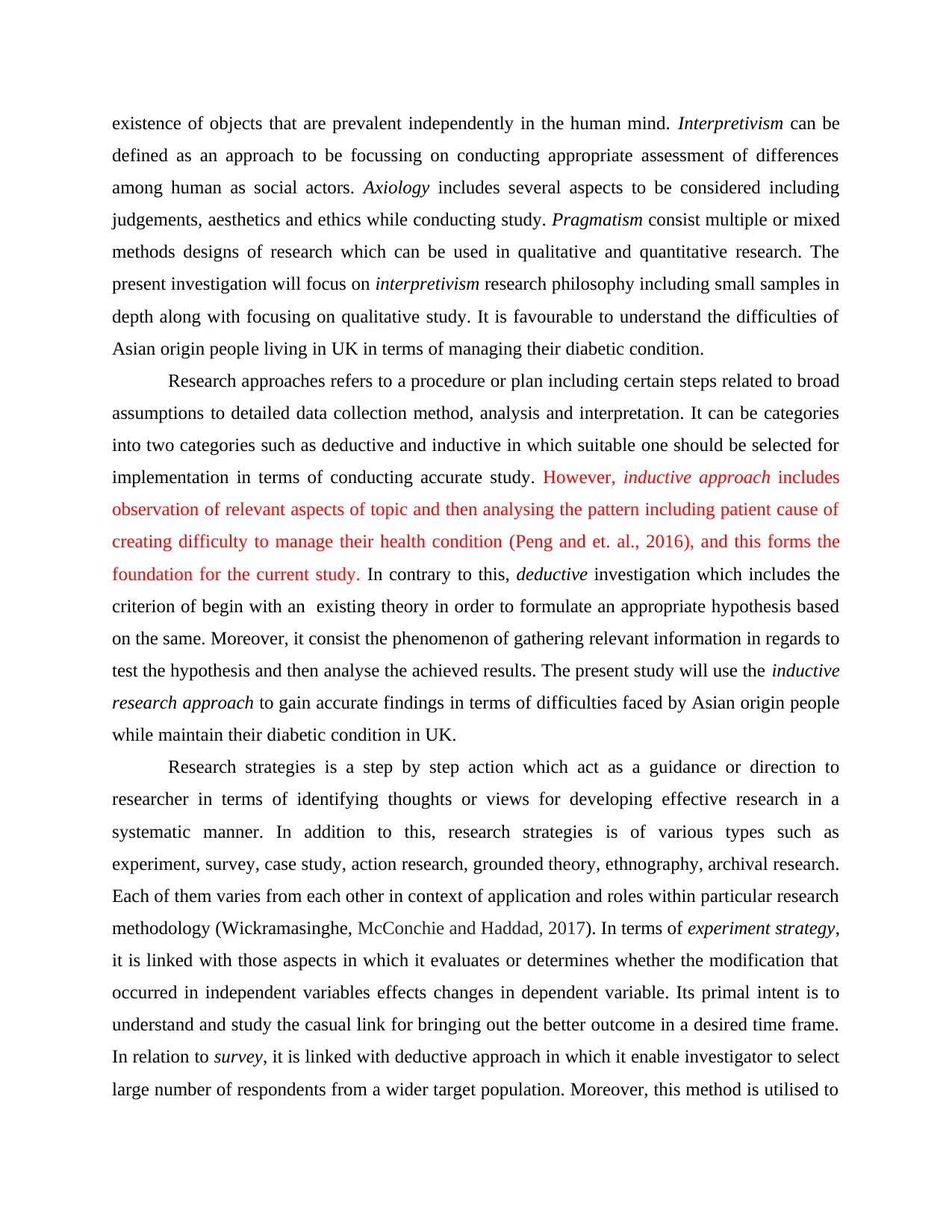
defined as an approach to be focussing on conducting appropriate assessment of differences
among human as social actors. Axiology includes several aspects to be considered including
judgements, aesthetics and ethics while conducting study. Pragmatism consist multiple or mixed
methods designs of research which can be used in qualitative and quantitative research. The
present investigation will focus on interpretivism research philosophy including small samples in
depth along with focusing on qualitative study. It is favourable to understand the difficulties of
Asian origin people living in UK in terms of managing their diabetic condition.
Research approaches refers to a procedure or plan including certain steps related to broad
assumptions to detailed data collection method, analysis and interpretation. It can be categories
into two categories such as deductive and inductive in which suitable one should be selected for
implementation in terms of conducting accurate study. However, inductive approach includes
observation of relevant aspects of topic and then analysing the pattern including patient cause of
creating difficulty to manage their health condition (Peng and et. al., 2016), and this forms the
foundation for the current study. In contrary to this, deductive investigation which includes the
criterion of begin with an existing theory in order to formulate an appropriate hypothesis based
on the same. Moreover, it consist the phenomenon of gathering relevant information in regards to
test the hypothesis and then analyse the achieved results. The present study will use the inductive
research approach to gain accurate findings in terms of difficulties faced by Asian origin people
while maintain their diabetic condition in UK.
Research strategies is a step by step action which act as a guidance or direction to
researcher in terms of identifying thoughts or views for developing effective research in a
systematic manner. In addition to this, research strategies is of various types such as
experiment, survey, case study, action research, grounded theory, ethnography, archival research.
Each of them varies from each other in context of application and roles within particular research
methodology (Wickramasinghe, McConchie and Haddad, 2017). In terms of experiment strategy,
it is linked with those aspects in which it evaluates or determines whether the modification that
occurred in independent variables effects changes in dependent variable. Its primal intent is to
understand and study the casual link for bringing out the better outcome in a desired time frame.
In relation to survey, it is linked with deductive approach in which it enable investigator to select
large number of respondents from a wider target population. Moreover, this method is utilised to
Paraphrase This Document
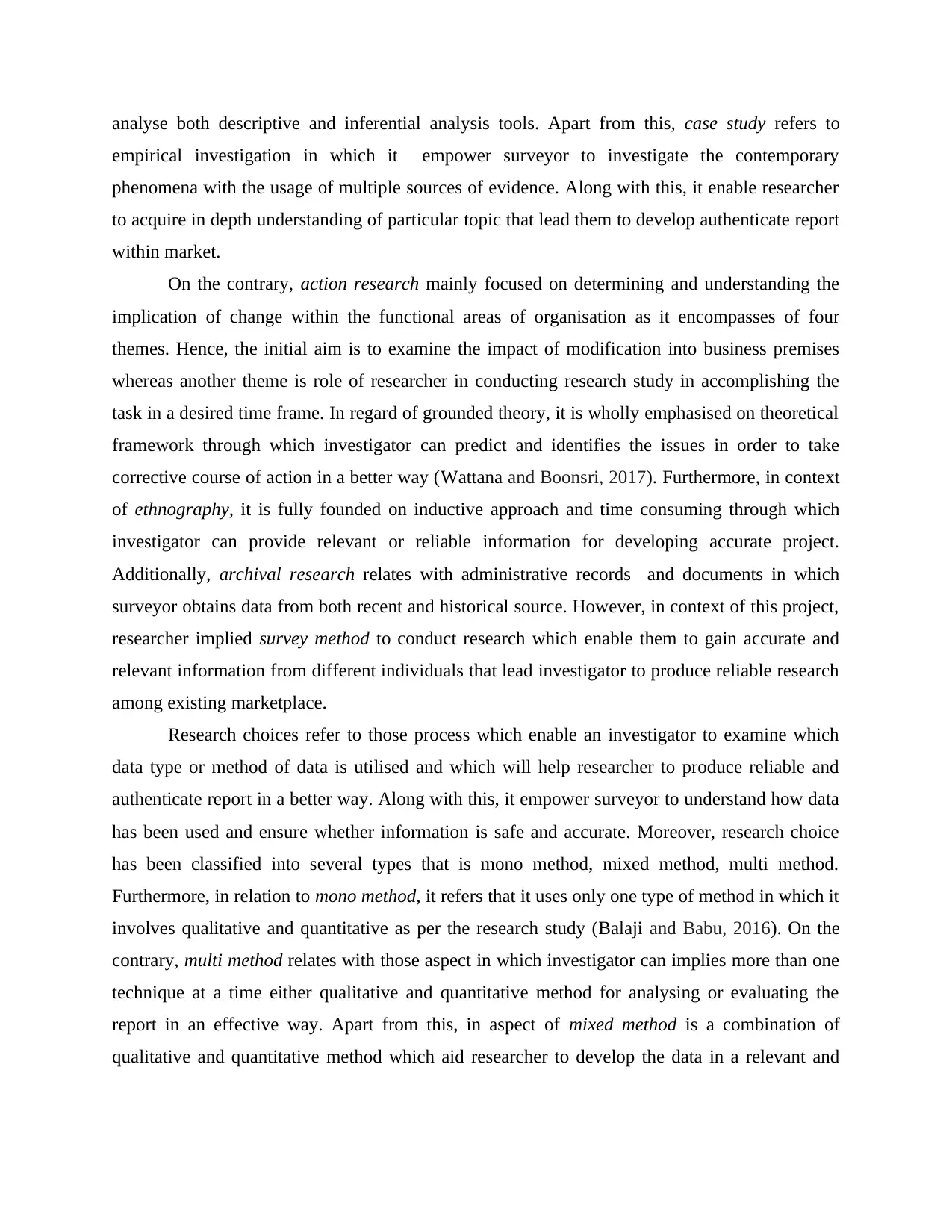
empirical investigation in which it empower surveyor to investigate the contemporary
phenomena with the usage of multiple sources of evidence. Along with this, it enable researcher
to acquire in depth understanding of particular topic that lead them to develop authenticate report
within market.
On the contrary, action research mainly focused on determining and understanding the
implication of change within the functional areas of organisation as it encompasses of four
themes. Hence, the initial aim is to examine the impact of modification into business premises
whereas another theme is role of researcher in conducting research study in accomplishing the
task in a desired time frame. In regard of grounded theory, it is wholly emphasised on theoretical
framework through which investigator can predict and identifies the issues in order to take
corrective course of action in a better way (Wattana and Boonsri, 2017). Furthermore, in context
of ethnography, it is fully founded on inductive approach and time consuming through which
investigator can provide relevant or reliable information for developing accurate project.
Additionally, archival research relates with administrative records and documents in which
surveyor obtains data from both recent and historical source. However, in context of this project,
researcher implied survey method to conduct research which enable them to gain accurate and
relevant information from different individuals that lead investigator to produce reliable research
among existing marketplace.
Research choices refer to those process which enable an investigator to examine which
data type or method of data is utilised and which will help researcher to produce reliable and
authenticate report in a better way. Along with this, it empower surveyor to understand how data
has been used and ensure whether information is safe and accurate. Moreover, research choice
has been classified into several types that is mono method, mixed method, multi method.
Furthermore, in relation to mono method, it refers that it uses only one type of method in which it
involves qualitative and quantitative as per the research study (Balaji and Babu, 2016). On the
contrary, multi method relates with those aspect in which investigator can implies more than one
technique at a time either qualitative and quantitative method for analysing or evaluating the
report in an effective way. Apart from this, in aspect of mixed method is a combination of
qualitative and quantitative method which aid researcher to develop the data in a relevant and
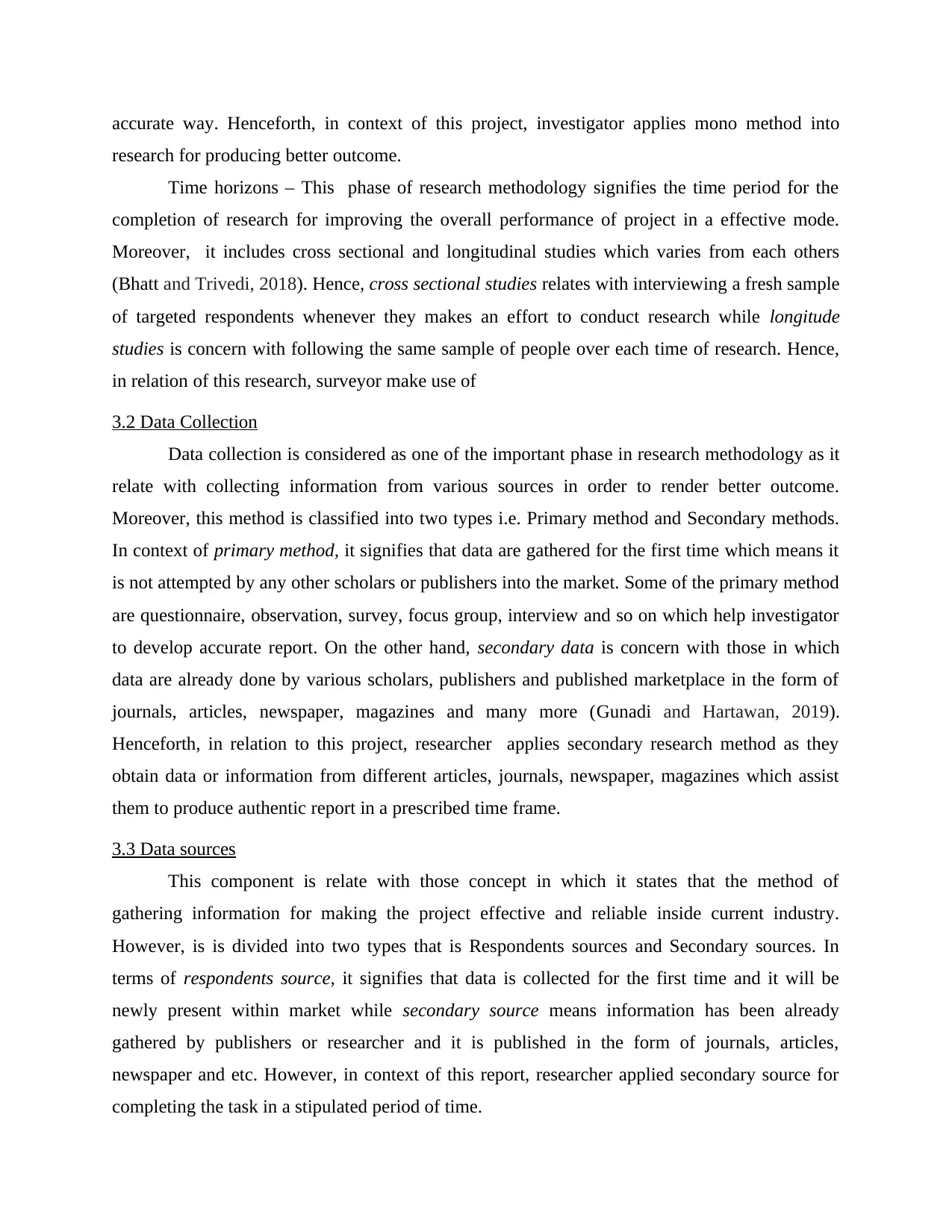
research for producing better outcome.
Time horizons – This phase of research methodology signifies the time period for the
completion of research for improving the overall performance of project in a effective mode.
Moreover, it includes cross sectional and longitudinal studies which varies from each others
(Bhatt and Trivedi, 2018). Hence, cross sectional studies relates with interviewing a fresh sample
of targeted respondents whenever they makes an effort to conduct research while longitude
studies is concern with following the same sample of people over each time of research. Hence,
in relation of this research, surveyor make use of
3.2 Data Collection
Data collection is considered as one of the important phase in research methodology as it
relate with collecting information from various sources in order to render better outcome.
Moreover, this method is classified into two types i.e. Primary method and Secondary methods.
In context of primary method, it signifies that data are gathered for the first time which means it
is not attempted by any other scholars or publishers into the market. Some of the primary method
are questionnaire, observation, survey, focus group, interview and so on which help investigator
to develop accurate report. On the other hand, secondary data is concern with those in which
data are already done by various scholars, publishers and published marketplace in the form of
journals, articles, newspaper, magazines and many more (Gunadi and Hartawan, 2019).
Henceforth, in relation to this project, researcher applies secondary research method as they
obtain data or information from different articles, journals, newspaper, magazines which assist
them to produce authentic report in a prescribed time frame.
3.3 Data sources
This component is relate with those concept in which it states that the method of
gathering information for making the project effective and reliable inside current industry.
However, is is divided into two types that is Respondents sources and Secondary sources. In
terms of respondents source, it signifies that data is collected for the first time and it will be
newly present within market while secondary source means information has been already
gathered by publishers or researcher and it is published in the form of journals, articles,
newspaper and etc. However, in context of this report, researcher applied secondary source for
completing the task in a stipulated period of time.
⊘ This is a preview!⊘
Do you want full access?
Subscribe today to unlock all pages.

Trusted by 1+ million students worldwide
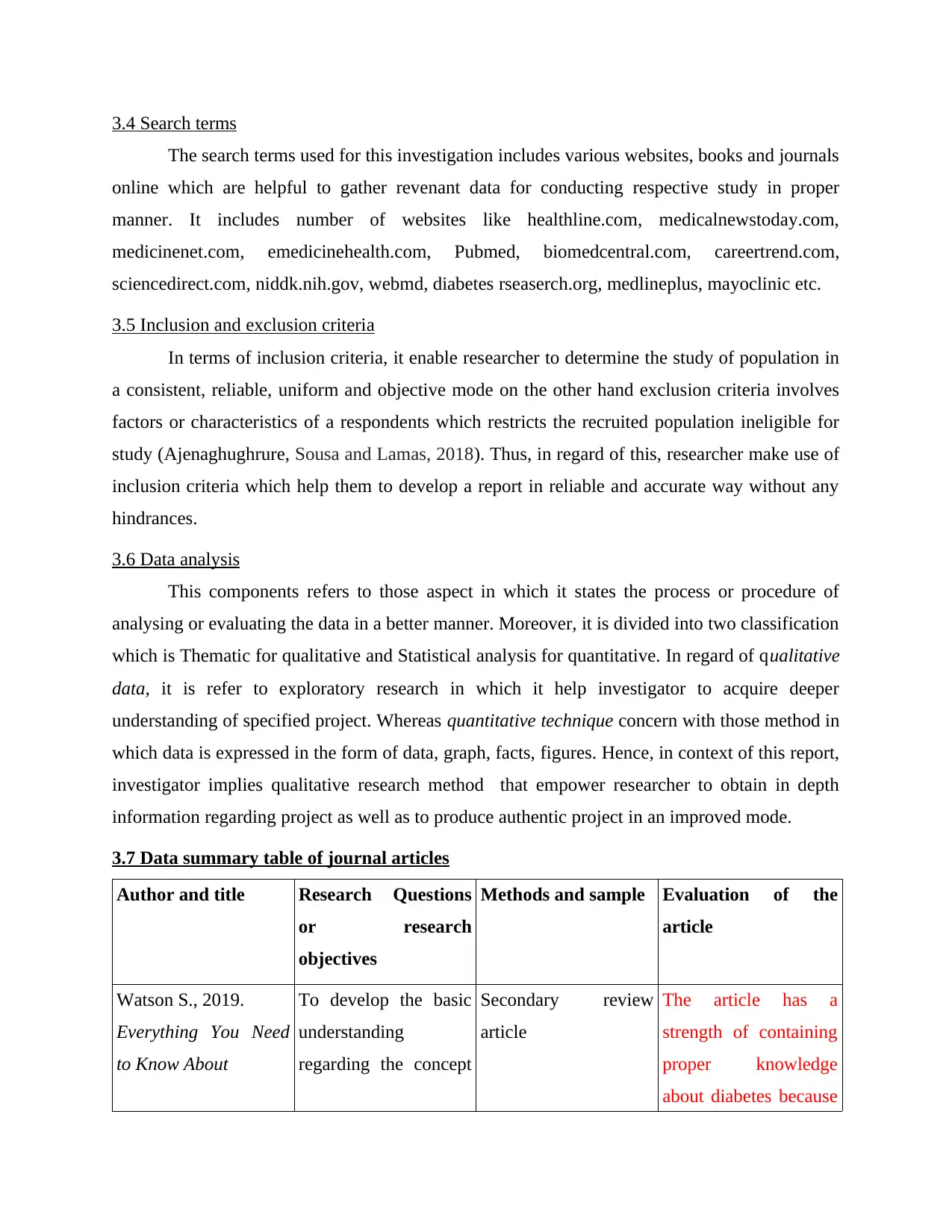
The search terms used for this investigation includes various websites, books and journals
online which are helpful to gather revenant data for conducting respective study in proper
manner. It includes number of websites like healthline.com, medicalnewstoday.com,
medicinenet.com, emedicinehealth.com, Pubmed, biomedcentral.com, careertrend.com,
sciencedirect.com, niddk.nih.gov, webmd, diabetes rseaserch.org, medlineplus, mayoclinic etc.
3.5 Inclusion and exclusion criteria
In terms of inclusion criteria, it enable researcher to determine the study of population in
a consistent, reliable, uniform and objective mode on the other hand exclusion criteria involves
factors or characteristics of a respondents which restricts the recruited population ineligible for
study (Ajenaghughrure, Sousa and Lamas, 2018). Thus, in regard of this, researcher make use of
inclusion criteria which help them to develop a report in reliable and accurate way without any
hindrances.
3.6 Data analysis
This components refers to those aspect in which it states the process or procedure of
analysing or evaluating the data in a better manner. Moreover, it is divided into two classification
which is Thematic for qualitative and Statistical analysis for quantitative. In regard of qualitative
data, it is refer to exploratory research in which it help investigator to acquire deeper
understanding of specified project. Whereas quantitative technique concern with those method in
which data is expressed in the form of data, graph, facts, figures. Hence, in context of this report,
investigator implies qualitative research method that empower researcher to obtain in depth
information regarding project as well as to produce authentic project in an improved mode.
3.7 Data summary table of journal articles
Author and title Research Questions
or research
objectives
Methods and sample Evaluation of the
article
Watson S., 2019.
Everything You Need
to Know About
To develop the basic
understanding
regarding the concept
Secondary review
article
The article has a
strength of containing
proper knowledge
about diabetes because
Paraphrase This Document
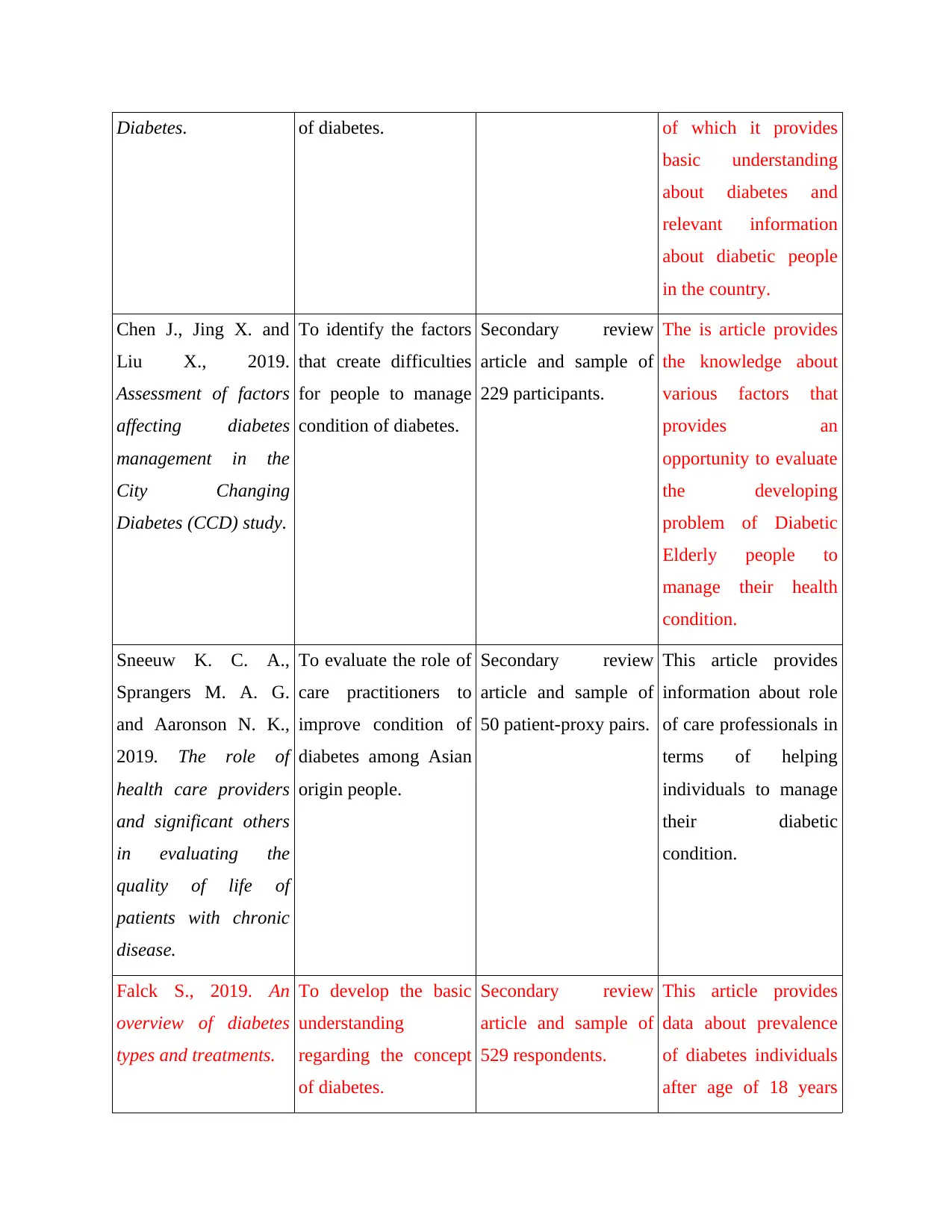
basic understanding
about diabetes and
relevant information
about diabetic people
in the country.
Chen J., Jing X. and
Liu X., 2019.
Assessment of factors
affecting diabetes
management in the
City Changing
Diabetes (CCD) study.
To identify the factors
that create difficulties
for people to manage
condition of diabetes.
Secondary review
article and sample of
229 participants.
The is article provides
the knowledge about
various factors that
provides an
opportunity to evaluate
the developing
problem of Diabetic
Elderly people to
manage their health
condition.
Sneeuw K. C. A.,
Sprangers M. A. G.
and Aaronson N. K.,
2019. The role of
health care providers
and significant others
in evaluating the
quality of life of
patients with chronic
disease.
To evaluate the role of
care practitioners to
improve condition of
diabetes among Asian
origin people.
Secondary review
article and sample of
50 patient-proxy pairs.
This article provides
information about role
of care professionals in
terms of helping
individuals to manage
their diabetic
condition.
Falck S., 2019. An
overview of diabetes
types and treatments.
To develop the basic
understanding
regarding the concept
of diabetes.
Secondary review
article and sample of
529 respondents.
This article provides
data about prevalence
of diabetes individuals
after age of 18 years
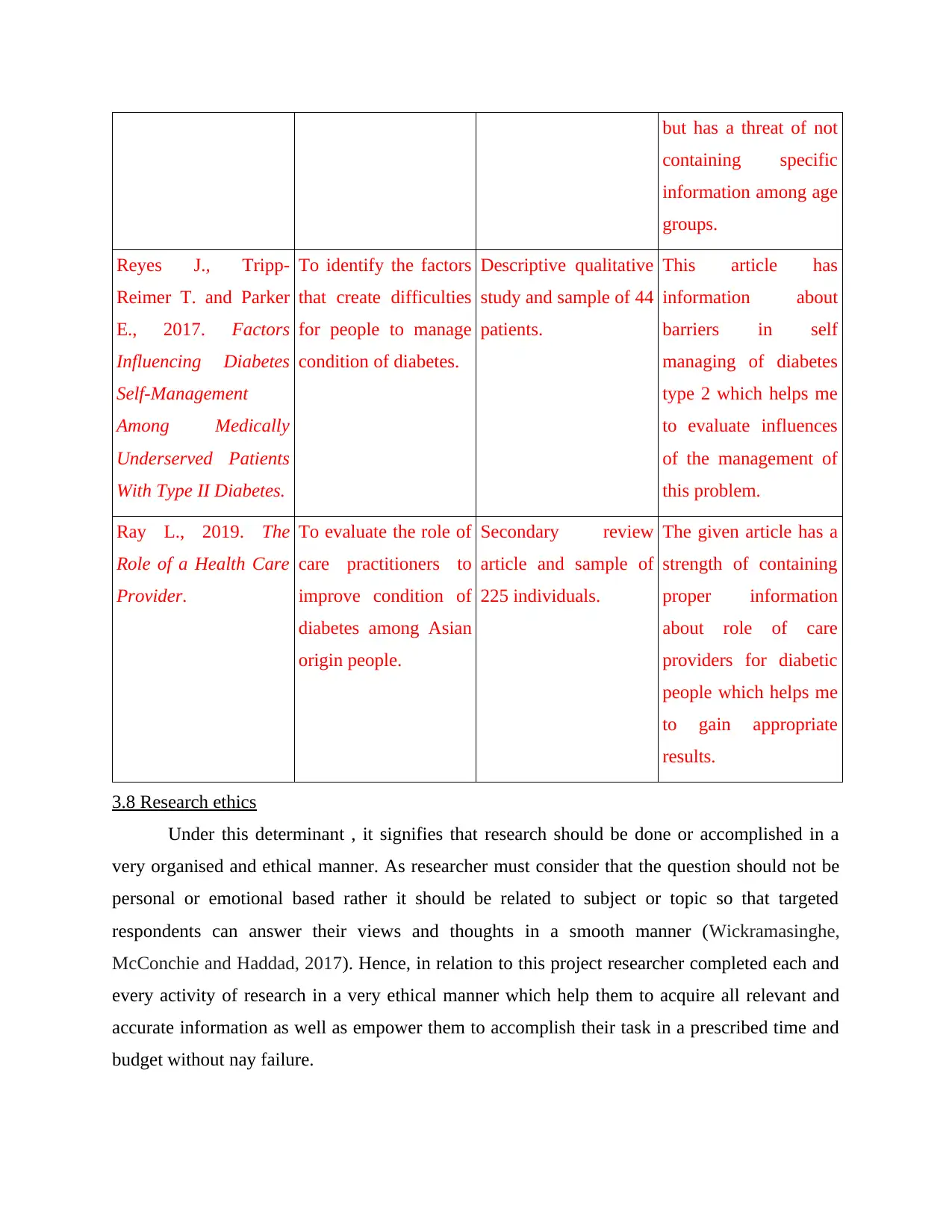
containing specific
information among age
groups.
Reyes J., Tripp-
Reimer T. and Parker
E., 2017. Factors
Influencing Diabetes
Self-Management
Among Medically
Underserved Patients
With Type II Diabetes.
To identify the factors
that create difficulties
for people to manage
condition of diabetes.
Descriptive qualitative
study and sample of 44
patients.
This article has
information about
barriers in self
managing of diabetes
type 2 which helps me
to evaluate influences
of the management of
this problem.
Ray L., 2019. The
Role of a Health Care
Provider.
To evaluate the role of
care practitioners to
improve condition of
diabetes among Asian
origin people.
Secondary review
article and sample of
225 individuals.
The given article has a
strength of containing
proper information
about role of care
providers for diabetic
people which helps me
to gain appropriate
results.
3.8 Research ethics
Under this determinant , it signifies that research should be done or accomplished in a
very organised and ethical manner. As researcher must consider that the question should not be
personal or emotional based rather it should be related to subject or topic so that targeted
respondents can answer their views and thoughts in a smooth manner (Wickramasinghe,
McConchie and Haddad, 2017). Hence, in relation to this project researcher completed each and
every activity of research in a very ethical manner which help them to acquire all relevant and
accurate information as well as empower them to accomplish their task in a prescribed time and
budget without nay failure.
⊘ This is a preview!⊘
Do you want full access?
Subscribe today to unlock all pages.

Trusted by 1+ million students worldwide
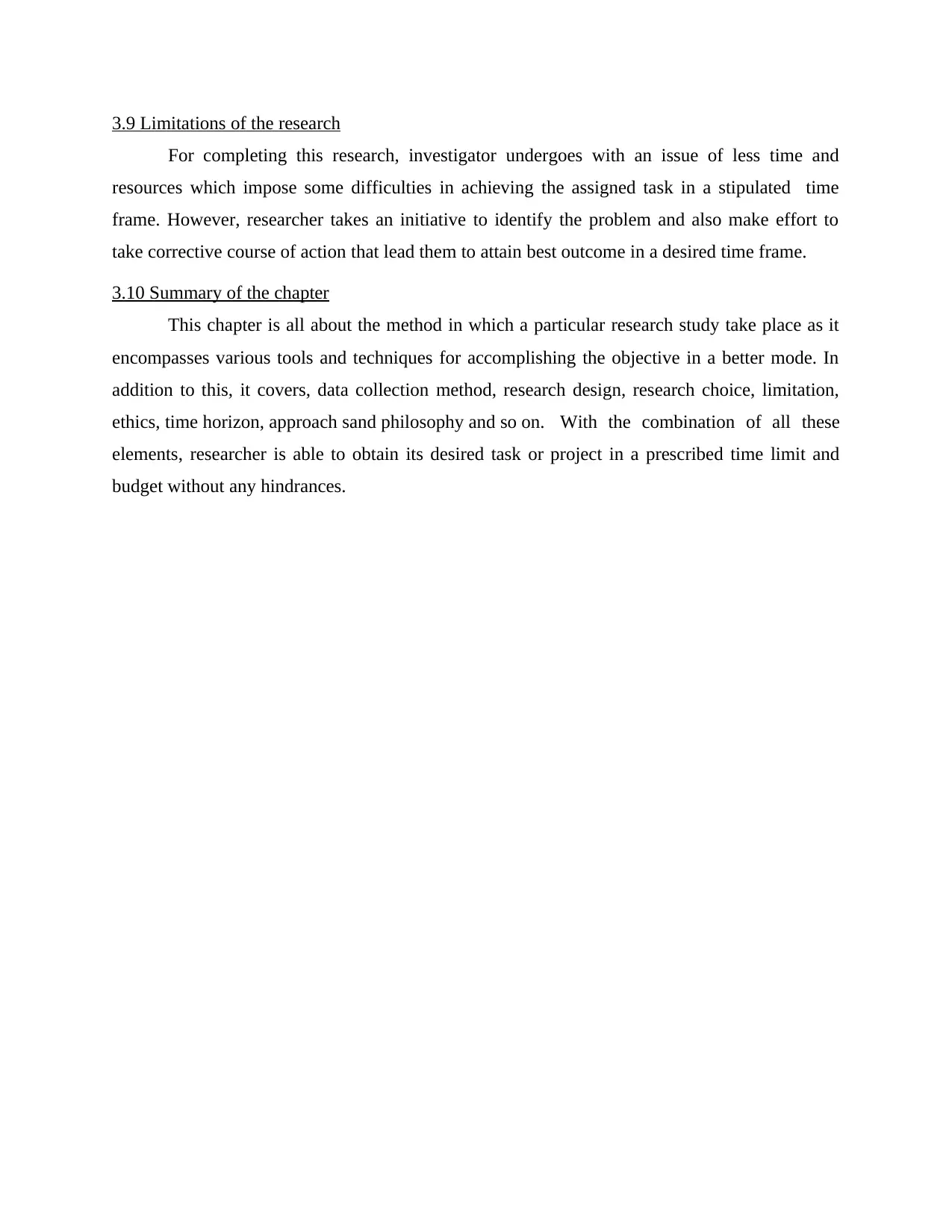
For completing this research, investigator undergoes with an issue of less time and
resources which impose some difficulties in achieving the assigned task in a stipulated time
frame. However, researcher takes an initiative to identify the problem and also make effort to
take corrective course of action that lead them to attain best outcome in a desired time frame.
3.10 Summary of the chapter
This chapter is all about the method in which a particular research study take place as it
encompasses various tools and techniques for accomplishing the objective in a better mode. In
addition to this, it covers, data collection method, research design, research choice, limitation,
ethics, time horizon, approach sand philosophy and so on. With the combination of all these
elements, researcher is able to obtain its desired task or project in a prescribed time limit and
budget without any hindrances.
Paraphrase This Document
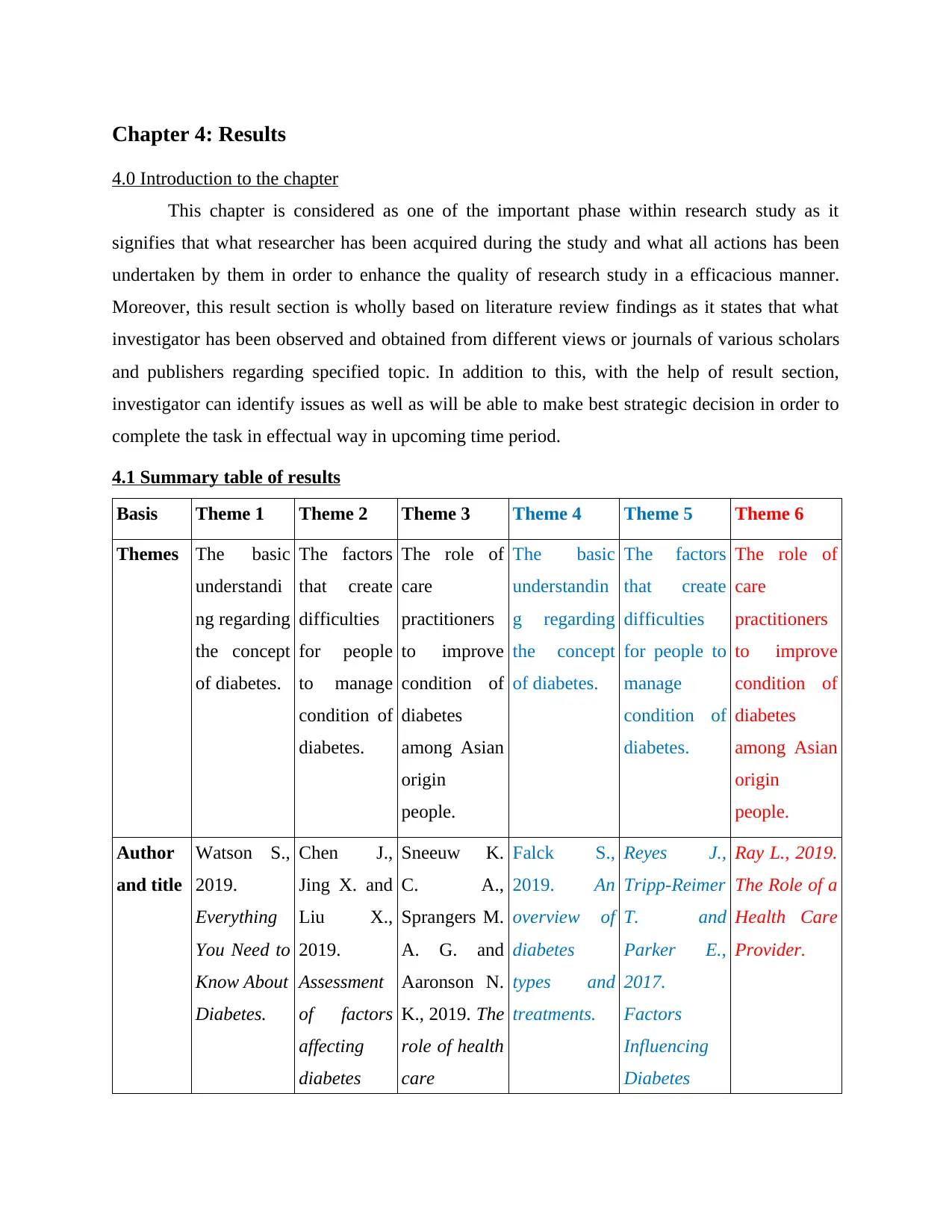
4.0 Introduction to the chapter
This chapter is considered as one of the important phase within research study as it
signifies that what researcher has been acquired during the study and what all actions has been
undertaken by them in order to enhance the quality of research study in a efficacious manner.
Moreover, this result section is wholly based on literature review findings as it states that what
investigator has been observed and obtained from different views or journals of various scholars
and publishers regarding specified topic. In addition to this, with the help of result section,
investigator can identify issues as well as will be able to make best strategic decision in order to
complete the task in effectual way in upcoming time period.
4.1 Summary table of results
Basis Theme 1 Theme 2 Theme 3 Theme 4 Theme 5 Theme 6
Themes The basic
understandi
ng regarding
the concept
of diabetes.
The factors
that create
difficulties
for people
to manage
condition of
diabetes.
The role of
care
practitioners
to improve
condition of
diabetes
among Asian
origin
people.
The basic
understandin
g regarding
the concept
of diabetes.
The factors
that create
difficulties
for people to
manage
condition of
diabetes.
The role of
care
practitioners
to improve
condition of
diabetes
among Asian
origin
people.
Author
and title
Watson S.,
2019.
Everything
You Need to
Know About
Diabetes.
Chen J.,
Jing X. and
Liu X.,
2019.
Assessment
of factors
affecting
diabetes
Sneeuw K.
C. A.,
Sprangers M.
A. G. and
Aaronson N.
K., 2019. The
role of health
care
Falck S.,
2019. An
overview of
diabetes
types and
treatments.
Reyes J.,
Tripp-Reimer
T. and
Parker E.,
2017.
Factors
Influencing
Diabetes
Ray L., 2019.
The Role of a
Health Care
Provider.
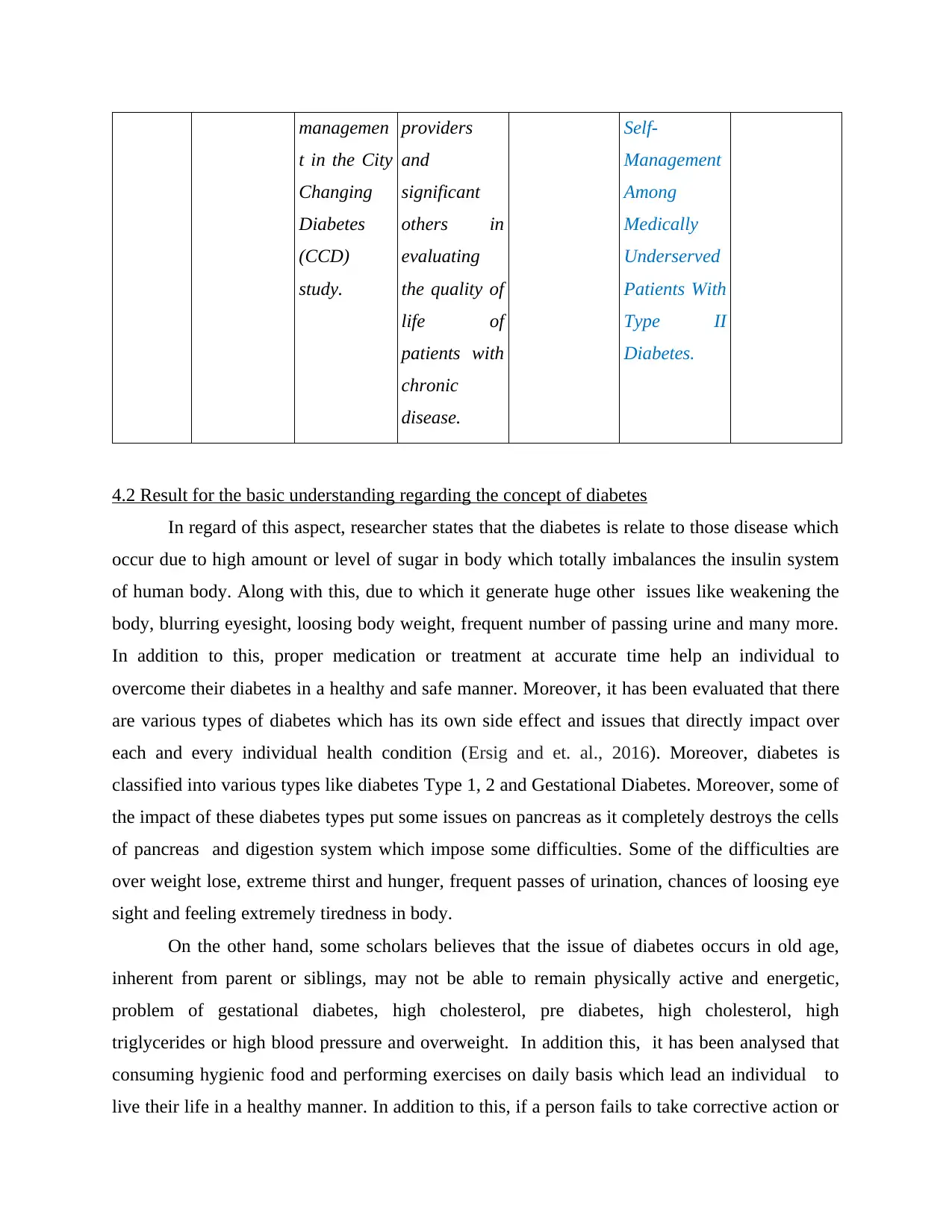
t in the City
Changing
Diabetes
(CCD)
study.
providers
and
significant
others in
evaluating
the quality of
life of
patients with
chronic
disease.
Self-
Management
Among
Medically
Underserved
Patients With
Type II
Diabetes.
4.2 Result for the basic understanding regarding the concept of diabetes
In regard of this aspect, researcher states that the diabetes is relate to those disease which
occur due to high amount or level of sugar in body which totally imbalances the insulin system
of human body. Along with this, due to which it generate huge other issues like weakening the
body, blurring eyesight, loosing body weight, frequent number of passing urine and many more.
In addition to this, proper medication or treatment at accurate time help an individual to
overcome their diabetes in a healthy and safe manner. Moreover, it has been evaluated that there
are various types of diabetes which has its own side effect and issues that directly impact over
each and every individual health condition (Ersig and et. al., 2016). Moreover, diabetes is
classified into various types like diabetes Type 1, 2 and Gestational Diabetes. Moreover, some of
the impact of these diabetes types put some issues on pancreas as it completely destroys the cells
of pancreas and digestion system which impose some difficulties. Some of the difficulties are
over weight lose, extreme thirst and hunger, frequent passes of urination, chances of loosing eye
sight and feeling extremely tiredness in body.
On the other hand, some scholars believes that the issue of diabetes occurs in old age,
inherent from parent or siblings, may not be able to remain physically active and energetic,
problem of gestational diabetes, high cholesterol, pre diabetes, high cholesterol, high
triglycerides or high blood pressure and overweight. In addition this, it has been analysed that
consuming hygienic food and performing exercises on daily basis which lead an individual to
live their life in a healthy manner. In addition to this, if a person fails to take corrective action or
⊘ This is a preview!⊘
Do you want full access?
Subscribe today to unlock all pages.

Trusted by 1+ million students worldwide

other hand, those who are not suffered with such issues they can ignore the fact but at the same
time can generate awareness among other mankind which help them to stay healthy and hygienic
(Huntriss, Campbell and Bedwell, 2018). So, maintaining proper health and adopting hygienic
environment enable each individual to lead a health and fit life without any obstacle.
4.3 Result for the factors that create difficulties for people to manage condition of diabetes
Considering the above literature review, it has been analysed that management of
diabetes is very important otherwise it will become complicated. It includes the chance of
occurring severe complexities which are difficult to manage by strong efforts of care
practitioners. However, it is necessary to for diabetic patients to take effective precaution in
order to maintain the sugar levels in blood. It has been founded that people belongs to Asian
origin did not have much good condition in UK so that they are facing various problems in terms
of managing their diabetic situation. It involves number of factors which are responsible for
creating difficulties in terms of managing condition their condition of diabetes. Meanwhile, it is
observed that these elements are required to be identified and establish appropriate strategies to
overcome with them.
It has been founded that fund related problems plays a major role in terms of develop
issues for Asian Diabetic people because they are not capable to afford expensive medical
facilities. It includes several situations like limited compensation or income and lack of
employment due to which they cannot fulfil their basic needs like food, water, shelter and
medicines. However, it has been determined that people with lack of funds are not able to tale
different required insulin treatments which is responsible for creating problem of increased sugar
levels for them (Alharbi and et. al., 2017. It is observed that extreme complications in diabetic
condition can develop various other severe disease ore may leads to death of an individual. The
important strategy for managing diabetic condition at individual level is to take effective
precautions in daily routine like avoid oily or junk food, physical exercises & meditation daily,
take medicine on time and strictly avoid sweet dishes respectively.
On the other hand, it has been evaluated that severity if disease is also responsible for
generating extreme condition of patient which is not able to deal with easily. It requires
additional and perfect efforts of medical professionals in order to maintain complicated situation.
However, it is also identified that severity of diabetes can create other severe heath problems like
Paraphrase This Document

medical facilities can be considered to be accountable for poor management of diabetes for Asian
origin people living in UK. It is observed that many times, care practitioners did not pay
attention to them which is a kind of discrimination due to which patients may gain severe
condition (Lee and et. al., 2016). It is determined that Life restrictions also plays major role in
creating difficulty to manage diabetic condition including several factors like sedentary lifestyle,
sitting job, habit of eating junk food etc. It is necessary for people to change their inappropriate
lifestyle in terms of making themselves well-being.
The management of Type 2 diabetes includes the intake of insulin and control diet in order to
maintain blood sugar level. It has been analysed that it is necessary for patient with this kind of
diabetes focus on their weight loss and proper balanced diet which facilitate improvement in
their condition. However, culture influences the management because some of people have
religion in which they believe that extra body weight reflects about wealth and prosperity.
Meanwhile, such type of culture influence the management of type 2 diabetes because strict diet
and proper weight loss is very important to maintain blood glucose level.
There are several language barriers including the situation when patient only knows their local
language then it creates problem for care professional. It is observed that medical practitioners
were not able to make people understand about their balanced diet including the things they can
eat or things which they cannot eat for maintaining their health properly. Another language
barrier is when doctor communicate very fast and patient do not understand what did they said
then also management become quite difficult. It is necessary for practitioners to have a translator
to communicate effectively with patient and use small & clear sentences by communicating
slowly to facilitate management of type 2 diabetes easy.
4.5 Result for the role of care practitioners to improve condition of diabetes among Asian origin
people
Considering the above information, it has been analysed that car practitioners has major
role in terms of managing diabetic condition of Asian origin people living in UK. It includes
their duty of making patients aware about habits including in healthy lifestyle and encourage
them to adopt effective routine for managing sugar level in blood. However, it includes their role
of providing immediate attention as well as care facilities while patients requires to avoid
complications accordingly. Meanwhile, it is determined that medical professionals are required
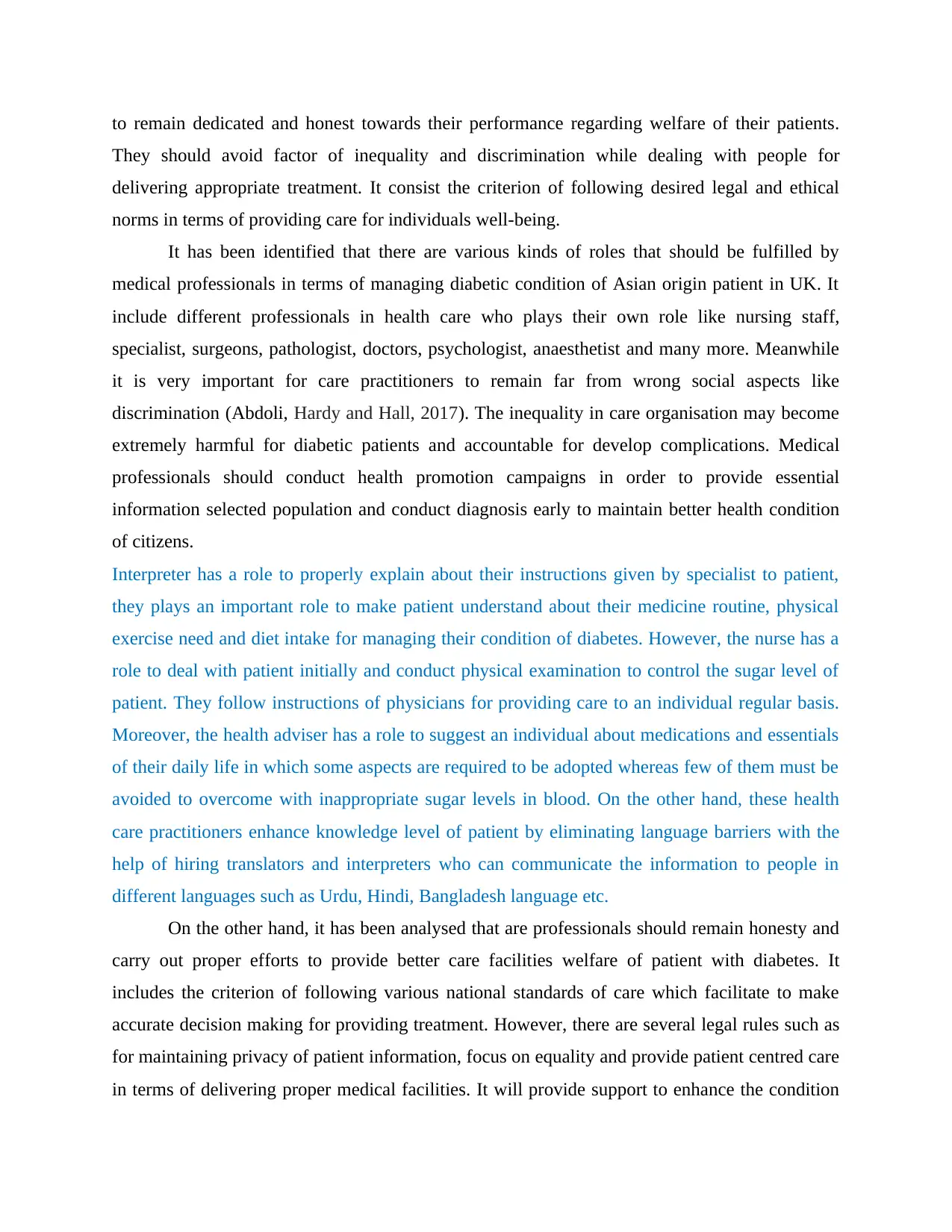
They should avoid factor of inequality and discrimination while dealing with people for
delivering appropriate treatment. It consist the criterion of following desired legal and ethical
norms in terms of providing care for individuals well-being.
It has been identified that there are various kinds of roles that should be fulfilled by
medical professionals in terms of managing diabetic condition of Asian origin patient in UK. It
include different professionals in health care who plays their own role like nursing staff,
specialist, surgeons, pathologist, doctors, psychologist, anaesthetist and many more. Meanwhile
it is very important for care practitioners to remain far from wrong social aspects like
discrimination (Abdoli, Hardy and Hall, 2017). The inequality in care organisation may become
extremely harmful for diabetic patients and accountable for develop complications. Medical
professionals should conduct health promotion campaigns in order to provide essential
information selected population and conduct diagnosis early to maintain better health condition
of citizens.
Interpreter has a role to properly explain about their instructions given by specialist to patient,
they plays an important role to make patient understand about their medicine routine, physical
exercise need and diet intake for managing their condition of diabetes. However, the nurse has a
role to deal with patient initially and conduct physical examination to control the sugar level of
patient. They follow instructions of physicians for providing care to an individual regular basis.
Moreover, the health adviser has a role to suggest an individual about medications and essentials
of their daily life in which some aspects are required to be adopted whereas few of them must be
avoided to overcome with inappropriate sugar levels in blood. On the other hand, these health
care practitioners enhance knowledge level of patient by eliminating language barriers with the
help of hiring translators and interpreters who can communicate the information to people in
different languages such as Urdu, Hindi, Bangladesh language etc.
On the other hand, it has been analysed that are professionals should remain honesty and
carry out proper efforts to provide better care facilities welfare of patient with diabetes. It
includes the criterion of following various national standards of care which facilitate to make
accurate decision making for providing treatment. However, there are several legal rules such as
for maintaining privacy of patient information, focus on equality and provide patient centred care
in terms of delivering proper medical facilities. It will provide support to enhance the condition
⊘ This is a preview!⊘
Do you want full access?
Subscribe today to unlock all pages.

Trusted by 1+ million students worldwide
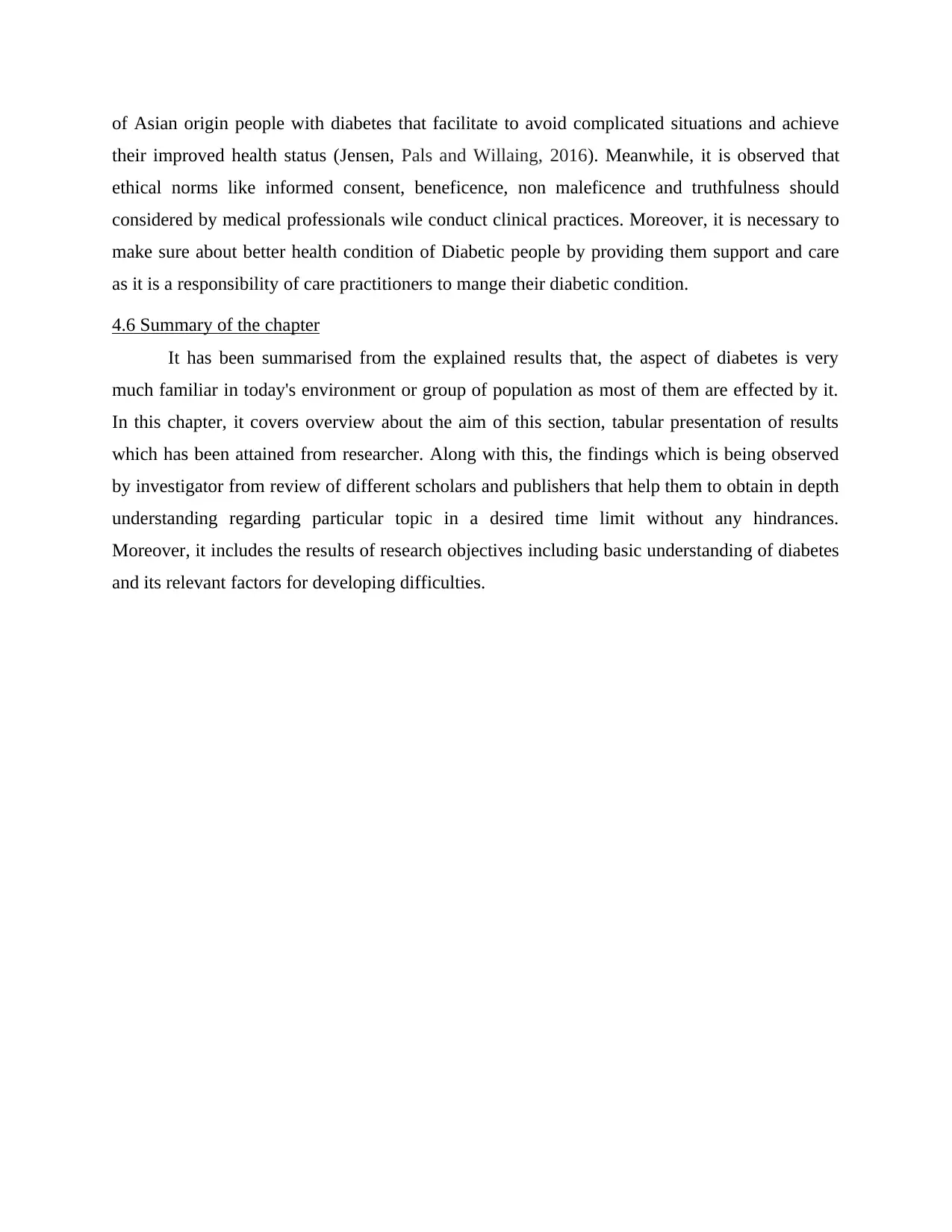
their improved health status (Jensen, Pals and Willaing, 2016). Meanwhile, it is observed that
ethical norms like informed consent, beneficence, non maleficence and truthfulness should
considered by medical professionals wile conduct clinical practices. Moreover, it is necessary to
make sure about better health condition of Diabetic people by providing them support and care
as it is a responsibility of care practitioners to mange their diabetic condition.
4.6 Summary of the chapter
It has been summarised from the explained results that, the aspect of diabetes is very
much familiar in today's environment or group of population as most of them are effected by it.
In this chapter, it covers overview about the aim of this section, tabular presentation of results
which has been attained from researcher. Along with this, the findings which is being observed
by investigator from review of different scholars and publishers that help them to obtain in depth
understanding regarding particular topic in a desired time limit without any hindrances.
Moreover, it includes the results of research objectives including basic understanding of diabetes
and its relevant factors for developing difficulties.
Paraphrase This Document
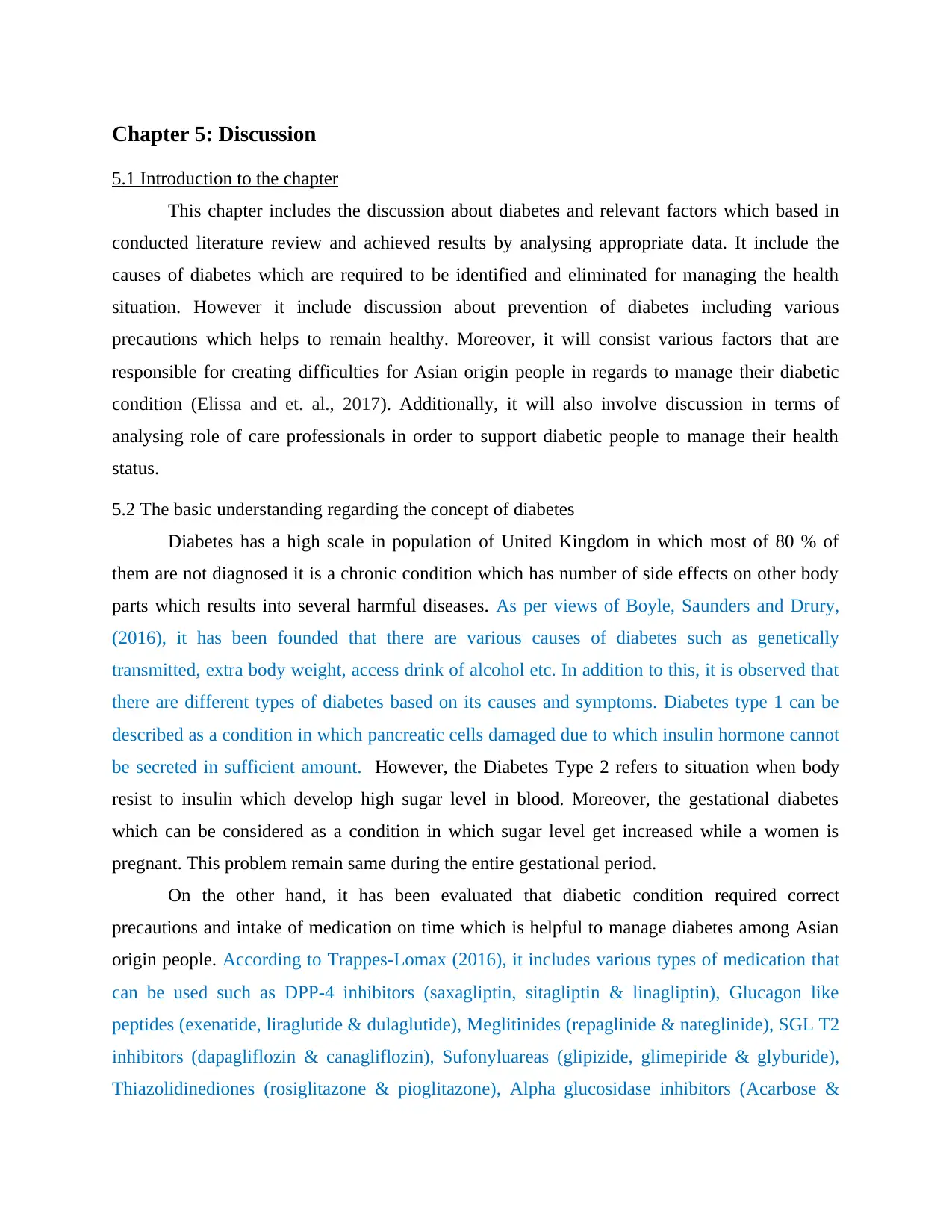
5.1 Introduction to the chapter
This chapter includes the discussion about diabetes and relevant factors which based in
conducted literature review and achieved results by analysing appropriate data. It include the
causes of diabetes which are required to be identified and eliminated for managing the health
situation. However it include discussion about prevention of diabetes including various
precautions which helps to remain healthy. Moreover, it will consist various factors that are
responsible for creating difficulties for Asian origin people in regards to manage their diabetic
condition (Elissa and et. al., 2017). Additionally, it will also involve discussion in terms of
analysing role of care professionals in order to support diabetic people to manage their health
status.
5.2 The basic understanding regarding the concept of diabetes
Diabetes has a high scale in population of United Kingdom in which most of 80 % of
them are not diagnosed it is a chronic condition which has number of side effects on other body
parts which results into several harmful diseases. As per views of Boyle, Saunders and Drury,
(2016), it has been founded that there are various causes of diabetes such as genetically
transmitted, extra body weight, access drink of alcohol etc. In addition to this, it is observed that
there are different types of diabetes based on its causes and symptoms. Diabetes type 1 can be
described as a condition in which pancreatic cells damaged due to which insulin hormone cannot
be secreted in sufficient amount. However, the Diabetes Type 2 refers to situation when body
resist to insulin which develop high sugar level in blood. Moreover, the gestational diabetes
which can be considered as a condition in which sugar level get increased while a women is
pregnant. This problem remain same during the entire gestational period.
On the other hand, it has been evaluated that diabetic condition required correct
precautions and intake of medication on time which is helpful to manage diabetes among Asian
origin people. According to Trappes-Lomax (2016), it includes various types of medication that
can be used such as DPP-4 inhibitors (saxagliptin, sitagliptin & linagliptin), Glucagon like
peptides (exenatide, liraglutide & dulaglutide), Meglitinides (repaglinide & nateglinide), SGL T2
inhibitors (dapagliflozin & canagliflozin), Sufonyluareas (glipizide, glimepiride & glyburide),
Thiazolidinediones (rosiglitazone & pioglitazone), Alpha glucosidase inhibitors (Acarbose &
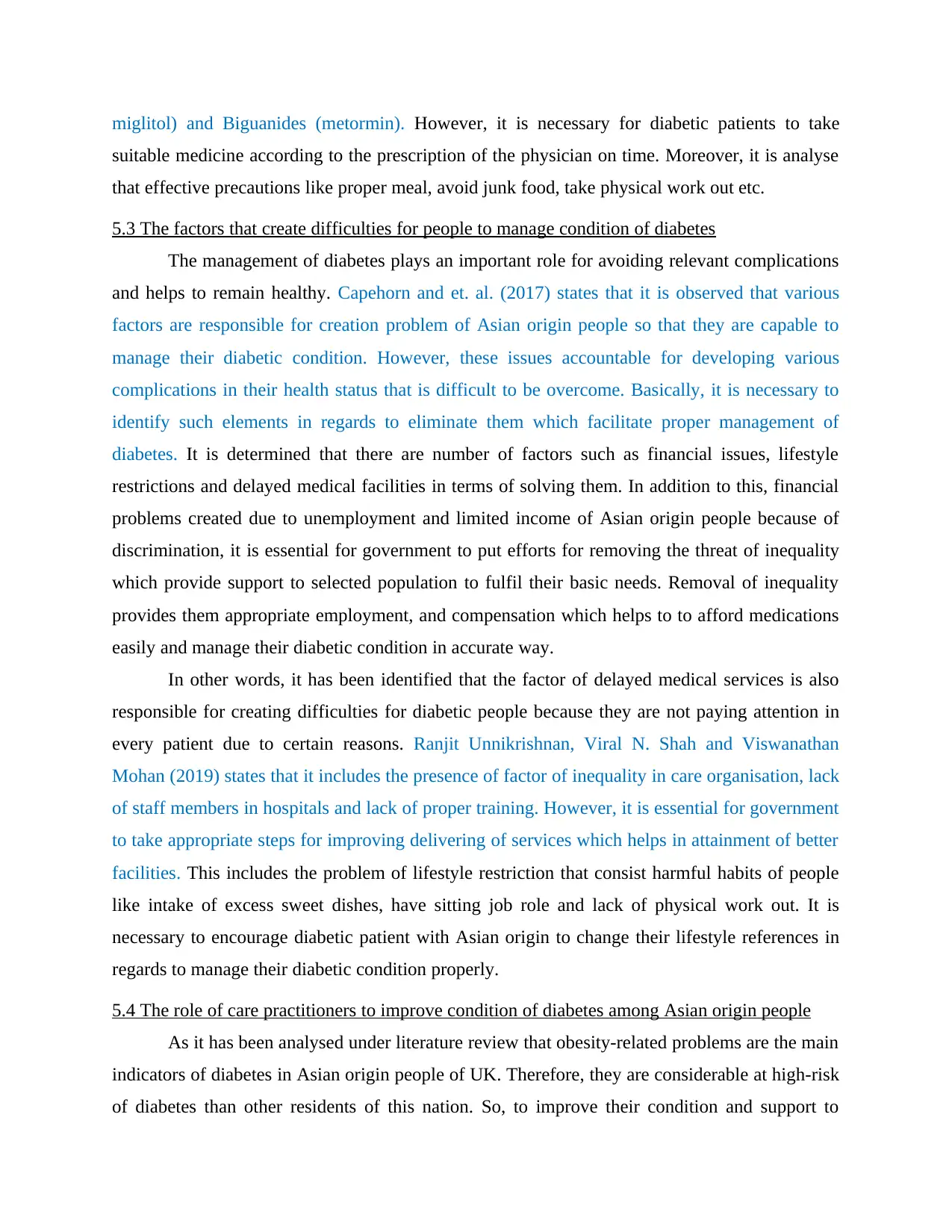
suitable medicine according to the prescription of the physician on time. Moreover, it is analyse
that effective precautions like proper meal, avoid junk food, take physical work out etc.
5.3 The factors that create difficulties for people to manage condition of diabetes
The management of diabetes plays an important role for avoiding relevant complications
and helps to remain healthy. Capehorn and et. al. (2017) states that it is observed that various
factors are responsible for creation problem of Asian origin people so that they are capable to
manage their diabetic condition. However, these issues accountable for developing various
complications in their health status that is difficult to be overcome. Basically, it is necessary to
identify such elements in regards to eliminate them which facilitate proper management of
diabetes. It is determined that there are number of factors such as financial issues, lifestyle
restrictions and delayed medical facilities in terms of solving them. In addition to this, financial
problems created due to unemployment and limited income of Asian origin people because of
discrimination, it is essential for government to put efforts for removing the threat of inequality
which provide support to selected population to fulfil their basic needs. Removal of inequality
provides them appropriate employment, and compensation which helps to to afford medications
easily and manage their diabetic condition in accurate way.
In other words, it has been identified that the factor of delayed medical services is also
responsible for creating difficulties for diabetic people because they are not paying attention in
every patient due to certain reasons. Ranjit Unnikrishnan, Viral N. Shah and Viswanathan
Mohan (2019) states that it includes the presence of factor of inequality in care organisation, lack
of staff members in hospitals and lack of proper training. However, it is essential for government
to take appropriate steps for improving delivering of services which helps in attainment of better
facilities. This includes the problem of lifestyle restriction that consist harmful habits of people
like intake of excess sweet dishes, have sitting job role and lack of physical work out. It is
necessary to encourage diabetic patient with Asian origin to change their lifestyle references in
regards to manage their diabetic condition properly.
5.4 The role of care practitioners to improve condition of diabetes among Asian origin people
As it has been analysed under literature review that obesity-related problems are the main
indicators of diabetes in Asian origin people of UK. Therefore, they are considerable at high-risk
of diabetes than other residents of this nation. So, to improve their condition and support to
⊘ This is a preview!⊘
Do you want full access?
Subscribe today to unlock all pages.

Trusted by 1+ million students worldwide
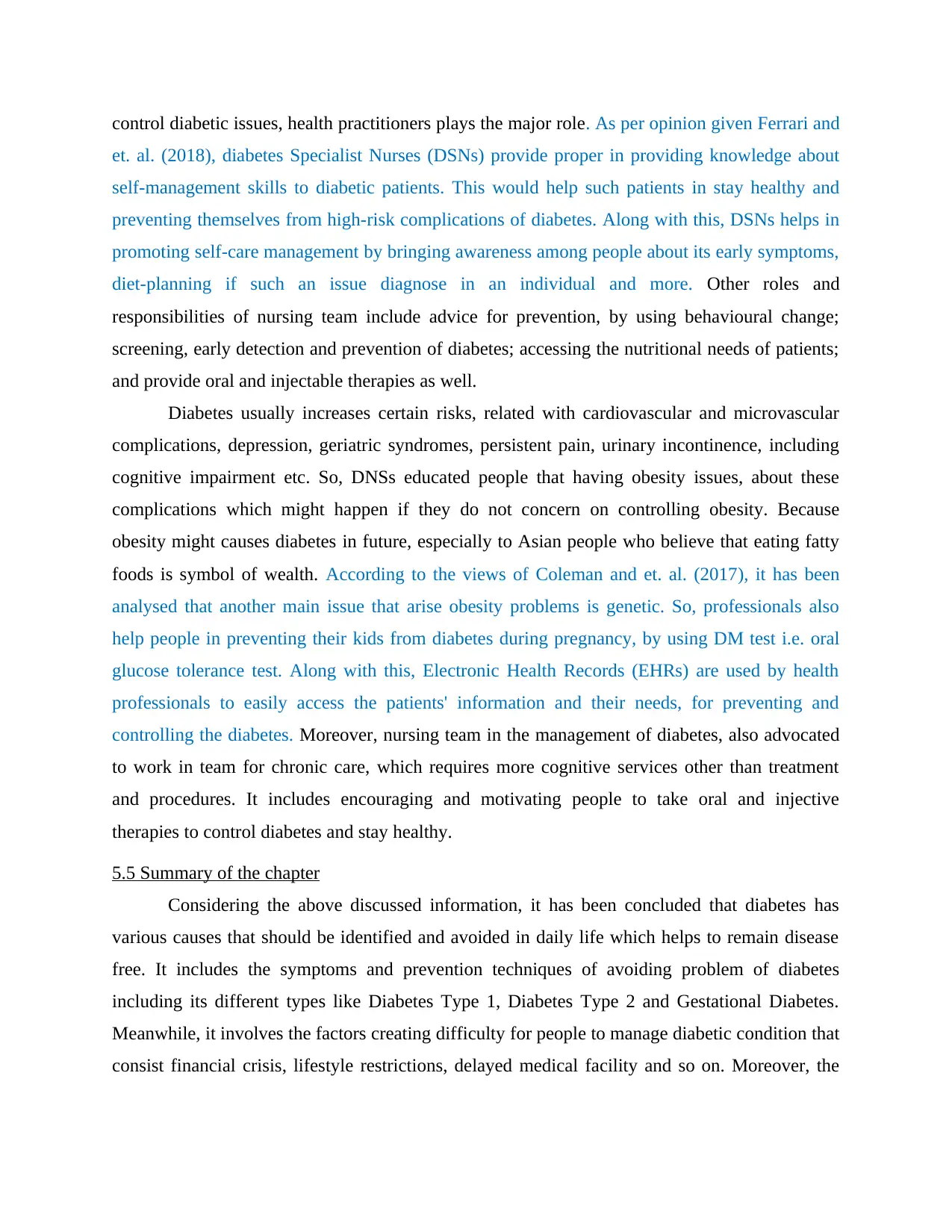
et. al. (2018), diabetes Specialist Nurses (DSNs) provide proper in providing knowledge about
self-management skills to diabetic patients. This would help such patients in stay healthy and
preventing themselves from high-risk complications of diabetes. Along with this, DSNs helps in
promoting self-care management by bringing awareness among people about its early symptoms,
diet-planning if such an issue diagnose in an individual and more. Other roles and
responsibilities of nursing team include advice for prevention, by using behavioural change;
screening, early detection and prevention of diabetes; accessing the nutritional needs of patients;
and provide oral and injectable therapies as well.
Diabetes usually increases certain risks, related with cardiovascular and microvascular
complications, depression, geriatric syndromes, persistent pain, urinary incontinence, including
cognitive impairment etc. So, DNSs educated people that having obesity issues, about these
complications which might happen if they do not concern on controlling obesity. Because
obesity might causes diabetes in future, especially to Asian people who believe that eating fatty
foods is symbol of wealth. According to the views of Coleman and et. al. (2017), it has been
analysed that another main issue that arise obesity problems is genetic. So, professionals also
help people in preventing their kids from diabetes during pregnancy, by using DM test i.e. oral
glucose tolerance test. Along with this, Electronic Health Records (EHRs) are used by health
professionals to easily access the patients' information and their needs, for preventing and
controlling the diabetes. Moreover, nursing team in the management of diabetes, also advocated
to work in team for chronic care, which requires more cognitive services other than treatment
and procedures. It includes encouraging and motivating people to take oral and injective
therapies to control diabetes and stay healthy.
5.5 Summary of the chapter
Considering the above discussed information, it has been concluded that diabetes has
various causes that should be identified and avoided in daily life which helps to remain disease
free. It includes the symptoms and prevention techniques of avoiding problem of diabetes
including its different types like Diabetes Type 1, Diabetes Type 2 and Gestational Diabetes.
Meanwhile, it involves the factors creating difficulty for people to manage diabetic condition that
consist financial crisis, lifestyle restrictions, delayed medical facility and so on. Moreover, the
Paraphrase This Document

factor of equality.

6.0 Introduction to the chapter
This chapter is end part of the whole research in which proper summary of entire study
will be described including relevant findings. It includes the overall sum up of the whole
investigation including important points of every chapter mentioned in the study. However, it
will consist the reflection of overall research allowing with effective recommendations which are
favourable to overcome with specific problem of this investigation. Moreover, it includes
information about various strategies that may helpful for solving problem of selected population
in terms of improving their health condition. This will also involves a small summary of this
chapter at the end.
6.1 Conclusions
From the above study, it has been concluded that, the most concerning issues for health
care practitioners is increasing patients of diabetes. People having rich lifestyle are mainly
suffered by this disease, due to intake of fatty and junk foods. As this present is carried out
especially on Asian people that lives in UK and are at high-risk of diabetes. So, health care
organisations of this nation identify their needs firsts, to support them to overcome or control
diabetes. For this purpose, they provide proper education to them about how obesity can cause
such a disease, so that they can prevent themselves from the same. Along with this, Diabetes
Specialist Nurses of UK give support to patients in self-care management, by designing a proper
diet-chart, oral and injective therapies etc. These professionals also play main role in assessing
and meeting needs of patients, by promoting self-care. As it has been summarised from the
report that apart from obesity and genetic issues, there are various factors present which rise
diabetic conditions under patients. Therefore, Government of UK also support in managing these
factors which include financial problems, that helps people in managing their diabetic issues.
6.2 Recommendations
Considering the above mentioned information, it has been recommended that government
authorities are required to provide proper employment opportunities to Asian origin people in
UK. It is necessary for them to earn required amount of funds so that they can easily fulfil their
basic needs like food, water,s helter and medicine. However, it is beneficial to improve their
financial condition in terms of supporting them for managing their diabetic condition
⊘ This is a preview!⊘
Do you want full access?
Subscribe today to unlock all pages.

Trusted by 1+ million students worldwide
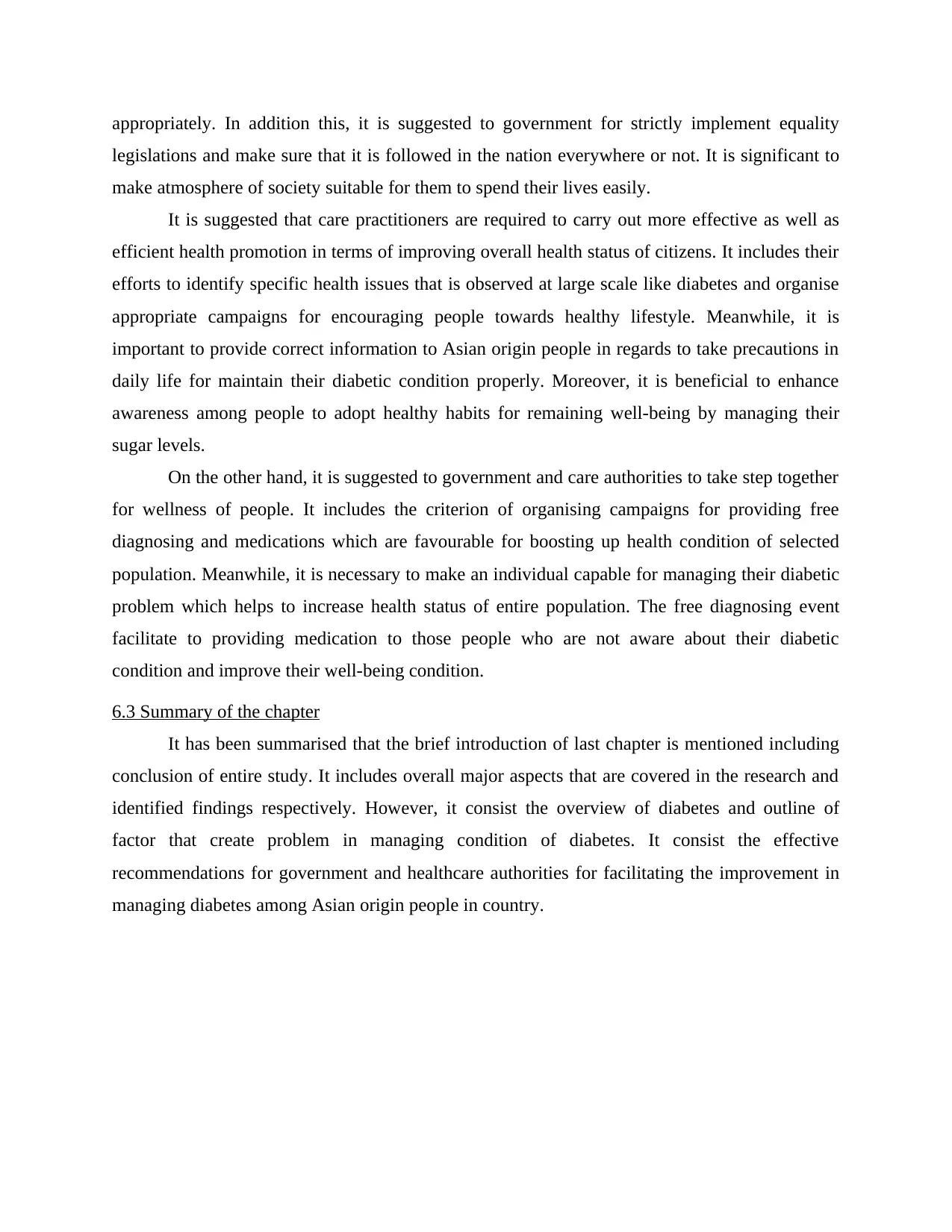
legislations and make sure that it is followed in the nation everywhere or not. It is significant to
make atmosphere of society suitable for them to spend their lives easily.
It is suggested that care practitioners are required to carry out more effective as well as
efficient health promotion in terms of improving overall health status of citizens. It includes their
efforts to identify specific health issues that is observed at large scale like diabetes and organise
appropriate campaigns for encouraging people towards healthy lifestyle. Meanwhile, it is
important to provide correct information to Asian origin people in regards to take precautions in
daily life for maintain their diabetic condition properly. Moreover, it is beneficial to enhance
awareness among people to adopt healthy habits for remaining well-being by managing their
sugar levels.
On the other hand, it is suggested to government and care authorities to take step together
for wellness of people. It includes the criterion of organising campaigns for providing free
diagnosing and medications which are favourable for boosting up health condition of selected
population. Meanwhile, it is necessary to make an individual capable for managing their diabetic
problem which helps to increase health status of entire population. The free diagnosing event
facilitate to providing medication to those people who are not aware about their diabetic
condition and improve their well-being condition.
6.3 Summary of the chapter
It has been summarised that the brief introduction of last chapter is mentioned including
conclusion of entire study. It includes overall major aspects that are covered in the research and
identified findings respectively. However, it consist the overview of diabetes and outline of
factor that create problem in managing condition of diabetes. It consist the effective
recommendations for government and healthcare authorities for facilitating the improvement in
managing diabetes among Asian origin people in country.
Paraphrase This Document
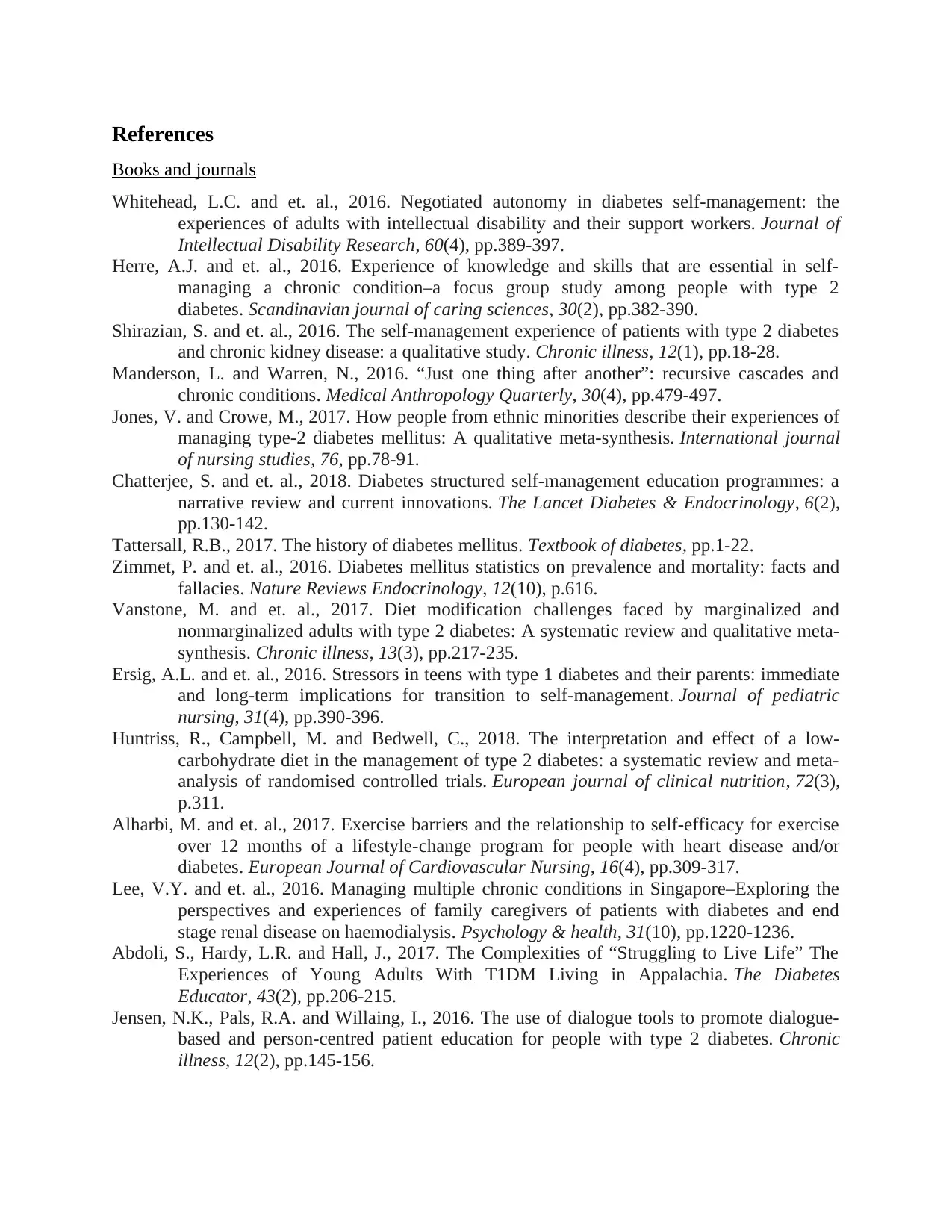
Books and journals
Whitehead, L.C. and et. al., 2016. Negotiated autonomy in diabetes self‐management: the
experiences of adults with intellectual disability and their support workers. Journal of
Intellectual Disability Research, 60(4), pp.389-397.
Herre, A.J. and et. al., 2016. Experience of knowledge and skills that are essential in self‐
managing a chronic condition–a focus group study among people with type 2
diabetes. Scandinavian journal of caring sciences, 30(2), pp.382-390.
Shirazian, S. and et. al., 2016. The self-management experience of patients with type 2 diabetes
and chronic kidney disease: a qualitative study. Chronic illness, 12(1), pp.18-28.
Manderson, L. and Warren, N., 2016. “Just one thing after another”: recursive cascades and
chronic conditions. Medical Anthropology Quarterly, 30(4), pp.479-497.
Jones, V. and Crowe, M., 2017. How people from ethnic minorities describe their experiences of
managing type-2 diabetes mellitus: A qualitative meta-synthesis. International journal
of nursing studies, 76, pp.78-91.
Chatterjee, S. and et. al., 2018. Diabetes structured self-management education programmes: a
narrative review and current innovations. The Lancet Diabetes & Endocrinology, 6(2),
pp.130-142.
Tattersall, R.B., 2017. The history of diabetes mellitus. Textbook of diabetes, pp.1-22.
Zimmet, P. and et. al., 2016. Diabetes mellitus statistics on prevalence and mortality: facts and
fallacies. Nature Reviews Endocrinology, 12(10), p.616.
Vanstone, M. and et. al., 2017. Diet modification challenges faced by marginalized and
nonmarginalized adults with type 2 diabetes: A systematic review and qualitative meta-
synthesis. Chronic illness, 13(3), pp.217-235.
Ersig, A.L. and et. al., 2016. Stressors in teens with type 1 diabetes and their parents: immediate
and long-term implications for transition to self-management. Journal of pediatric
nursing, 31(4), pp.390-396.
Huntriss, R., Campbell, M. and Bedwell, C., 2018. The interpretation and effect of a low-
carbohydrate diet in the management of type 2 diabetes: a systematic review and meta-
analysis of randomised controlled trials. European journal of clinical nutrition, 72(3),
p.311.
Alharbi, M. and et. al., 2017. Exercise barriers and the relationship to self-efficacy for exercise
over 12 months of a lifestyle-change program for people with heart disease and/or
diabetes. European Journal of Cardiovascular Nursing, 16(4), pp.309-317.
Lee, V.Y. and et. al., 2016. Managing multiple chronic conditions in Singapore–Exploring the
perspectives and experiences of family caregivers of patients with diabetes and end
stage renal disease on haemodialysis. Psychology & health, 31(10), pp.1220-1236.
Abdoli, S., Hardy, L.R. and Hall, J., 2017. The Complexities of “Struggling to Live Life” The
Experiences of Young Adults With T1DM Living in Appalachia. The Diabetes
Educator, 43(2), pp.206-215.
Jensen, N.K., Pals, R.A. and Willaing, I., 2016. The use of dialogue tools to promote dialogue-
based and person-centred patient education for people with type 2 diabetes. Chronic
illness, 12(2), pp.145-156.
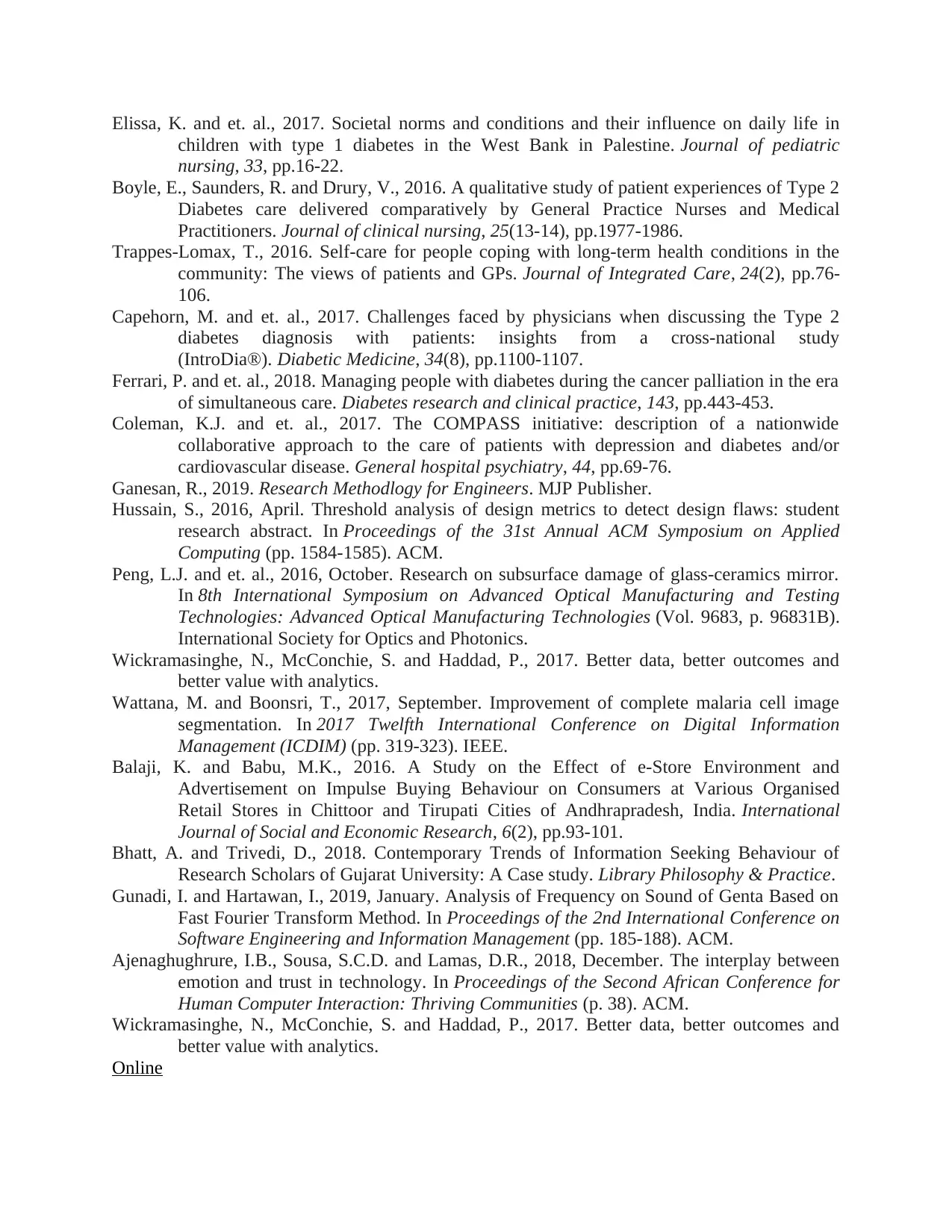
children with type 1 diabetes in the West Bank in Palestine. Journal of pediatric
nursing, 33, pp.16-22.
Boyle, E., Saunders, R. and Drury, V., 2016. A qualitative study of patient experiences of Type 2
Diabetes care delivered comparatively by General Practice Nurses and Medical
Practitioners. Journal of clinical nursing, 25(13-14), pp.1977-1986.
Trappes-Lomax, T., 2016. Self-care for people coping with long-term health conditions in the
community: The views of patients and GPs. Journal of Integrated Care, 24(2), pp.76-
106.
Capehorn, M. and et. al., 2017. Challenges faced by physicians when discussing the Type 2
diabetes diagnosis with patients: insights from a cross‐national study
(IntroDia®). Diabetic Medicine, 34(8), pp.1100-1107.
Ferrari, P. and et. al., 2018. Managing people with diabetes during the cancer palliation in the era
of simultaneous care. Diabetes research and clinical practice, 143, pp.443-453.
Coleman, K.J. and et. al., 2017. The COMPASS initiative: description of a nationwide
collaborative approach to the care of patients with depression and diabetes and/or
cardiovascular disease. General hospital psychiatry, 44, pp.69-76.
Ganesan, R., 2019. Research Methodlogy for Engineers. MJP Publisher.
Hussain, S., 2016, April. Threshold analysis of design metrics to detect design flaws: student
research abstract. In Proceedings of the 31st Annual ACM Symposium on Applied
Computing (pp. 1584-1585). ACM.
Peng, L.J. and et. al., 2016, October. Research on subsurface damage of glass-ceramics mirror.
In 8th International Symposium on Advanced Optical Manufacturing and Testing
Technologies: Advanced Optical Manufacturing Technologies (Vol. 9683, p. 96831B).
International Society for Optics and Photonics.
Wickramasinghe, N., McConchie, S. and Haddad, P., 2017. Better data, better outcomes and
better value with analytics.
Wattana, M. and Boonsri, T., 2017, September. Improvement of complete malaria cell image
segmentation. In 2017 Twelfth International Conference on Digital Information
Management (ICDIM) (pp. 319-323). IEEE.
Balaji, K. and Babu, M.K., 2016. A Study on the Effect of e-Store Environment and
Advertisement on Impulse Buying Behaviour on Consumers at Various Organised
Retail Stores in Chittoor and Tirupati Cities of Andhrapradesh, India. International
Journal of Social and Economic Research, 6(2), pp.93-101.
Bhatt, A. and Trivedi, D., 2018. Contemporary Trends of Information Seeking Behaviour of
Research Scholars of Gujarat University: A Case study. Library Philosophy & Practice.
Gunadi, I. and Hartawan, I., 2019, January. Analysis of Frequency on Sound of Genta Based on
Fast Fourier Transform Method. In Proceedings of the 2nd International Conference on
Software Engineering and Information Management (pp. 185-188). ACM.
Ajenaghughrure, I.B., Sousa, S.C.D. and Lamas, D.R., 2018, December. The interplay between
emotion and trust in technology. In Proceedings of the Second African Conference for
Human Computer Interaction: Thriving Communities (p. 38). ACM.
Wickramasinghe, N., McConchie, S. and Haddad, P., 2017. Better data, better outcomes and
better value with analytics.
Online
⊘ This is a preview!⊘
Do you want full access?
Subscribe today to unlock all pages.

Trusted by 1+ million students worldwide
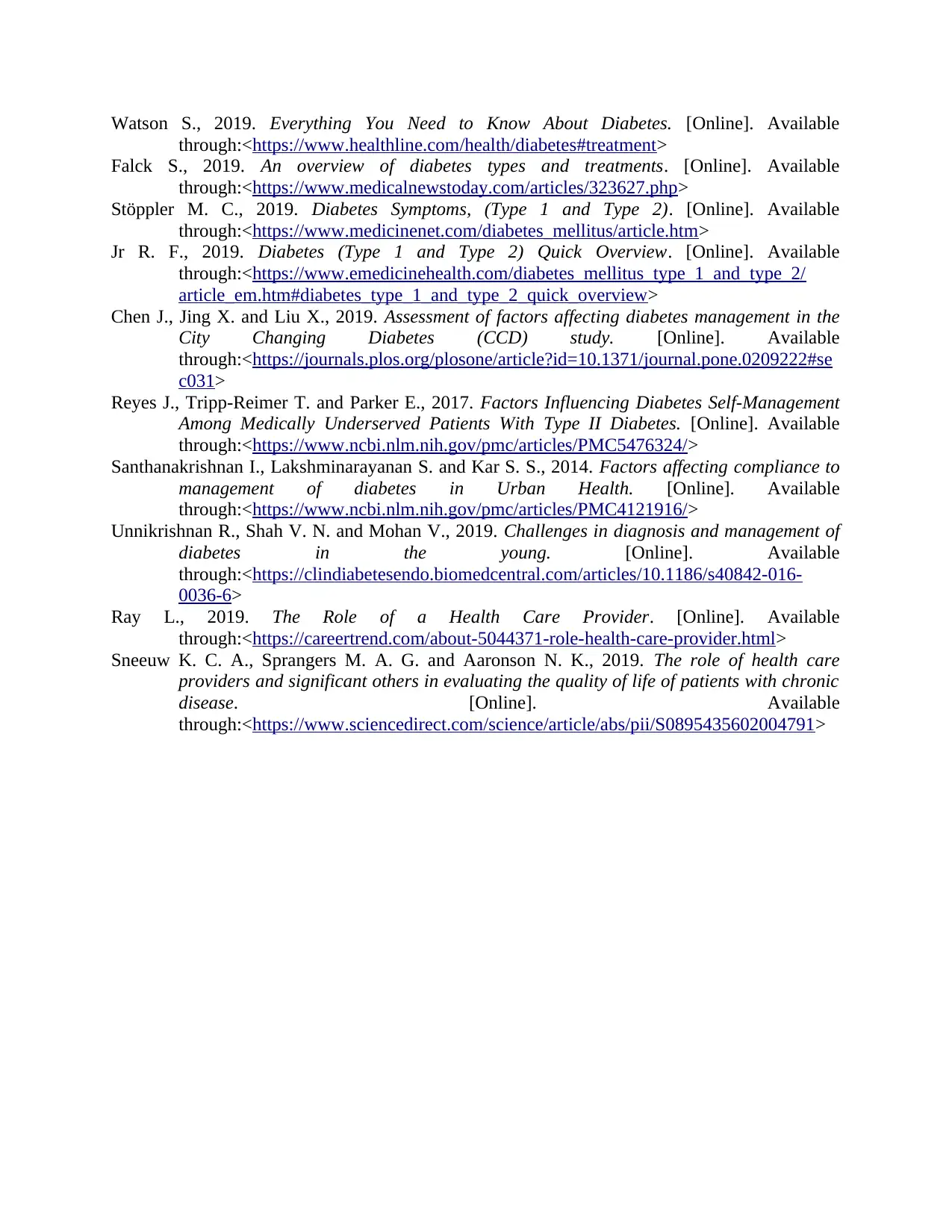
through:<https://www.healthline.com/health/diabetes#treatment>
Falck S., 2019. An overview of diabetes types and treatments. [Online]. Available
through:<https://www.medicalnewstoday.com/articles/323627.php>
Stöppler M. C., 2019. Diabetes Symptoms, (Type 1 and Type 2). [Online]. Available
through:<https://www.medicinenet.com/diabetes_mellitus/article.htm>
Jr R. F., 2019. Diabetes (Type 1 and Type 2) Quick Overview. [Online]. Available
through:<https://www.emedicinehealth.com/diabetes_mellitus_type_1_and_type_2/
article_em.htm#diabetes_type_1_and_type_2_quick_overview>
Chen J., Jing X. and Liu X., 2019. Assessment of factors affecting diabetes management in the
City Changing Diabetes (CCD) study. [Online]. Available
through:<https://journals.plos.org/plosone/article?id=10.1371/journal.pone.0209222#se
c031>
Reyes J., Tripp-Reimer T. and Parker E., 2017. Factors Influencing Diabetes Self-Management
Among Medically Underserved Patients With Type II Diabetes. [Online]. Available
through:<https://www.ncbi.nlm.nih.gov/pmc/articles/PMC5476324/>
Santhanakrishnan I., Lakshminarayanan S. and Kar S. S., 2014. Factors affecting compliance to
management of diabetes in Urban Health. [Online]. Available
through:<https://www.ncbi.nlm.nih.gov/pmc/articles/PMC4121916/>
Unnikrishnan R., Shah V. N. and Mohan V., 2019. Challenges in diagnosis and management of
diabetes in the young. [Online]. Available
through:<https://clindiabetesendo.biomedcentral.com/articles/10.1186/s40842-016-
0036-6>
Ray L., 2019. The Role of a Health Care Provider. [Online]. Available
through:<https://careertrend.com/about-5044371-role-health-care-provider.html>
Sneeuw K. C. A., Sprangers M. A. G. and Aaronson N. K., 2019. The role of health care
providers and significant others in evaluating the quality of life of patients with chronic
disease. [Online]. Available
through:<https://www.sciencedirect.com/science/article/abs/pii/S0895435602004791>
Related Documents
Your All-in-One AI-Powered Toolkit for Academic Success.
+13062052269
info@desklib.com
Available 24*7 on WhatsApp / Email
![[object Object]](/_next/static/media/star-bottom.7253800d.svg)
© 2024 | Zucol Services PVT LTD | All rights reserved.





